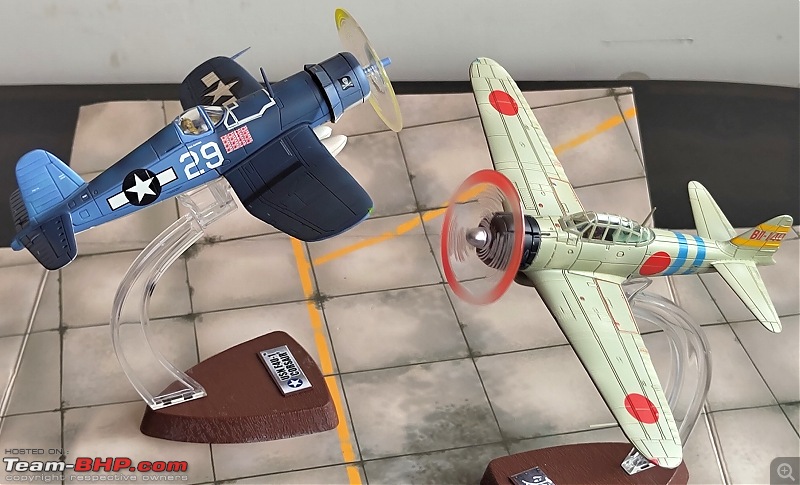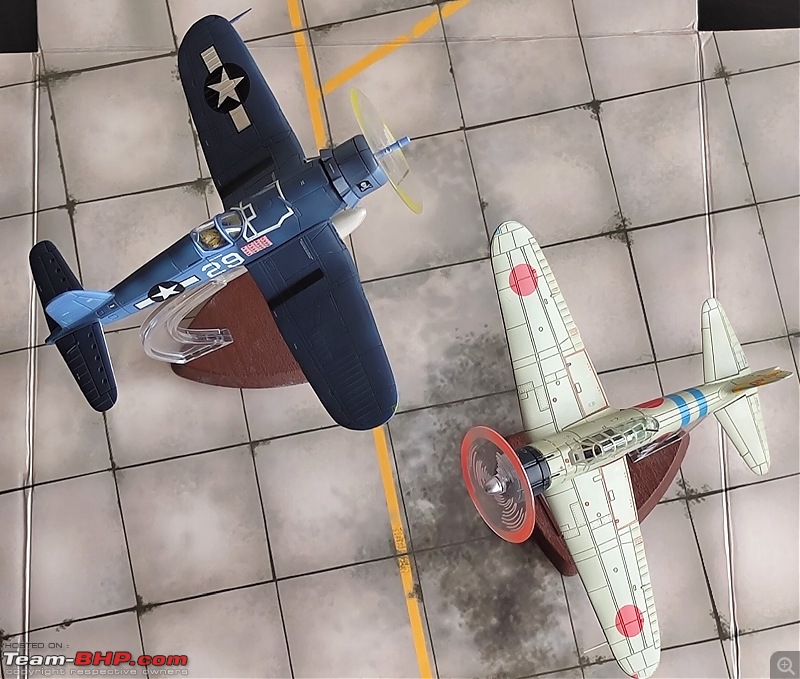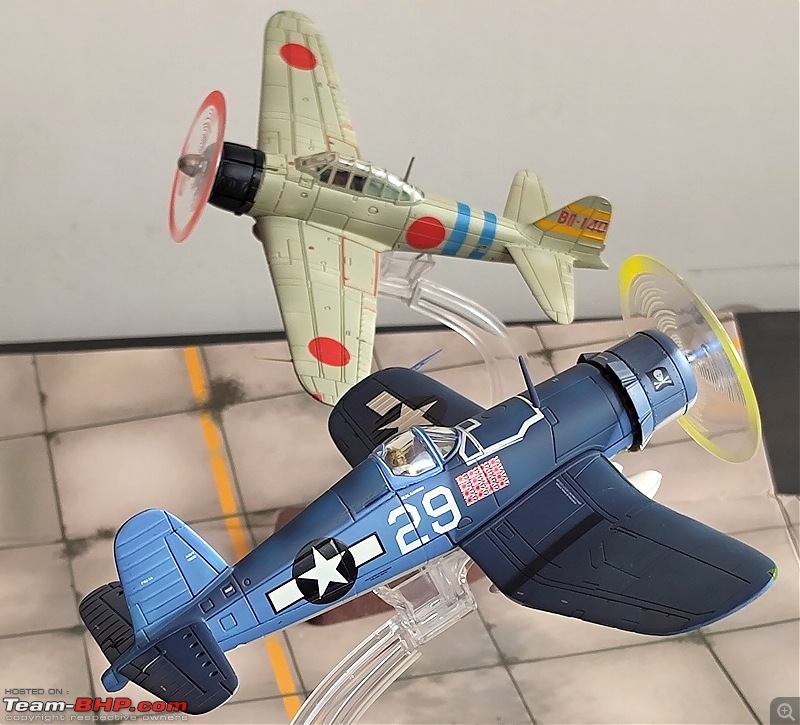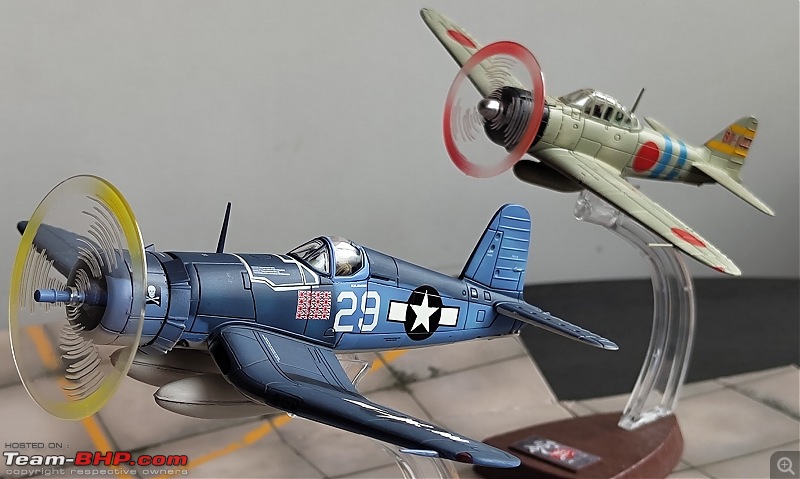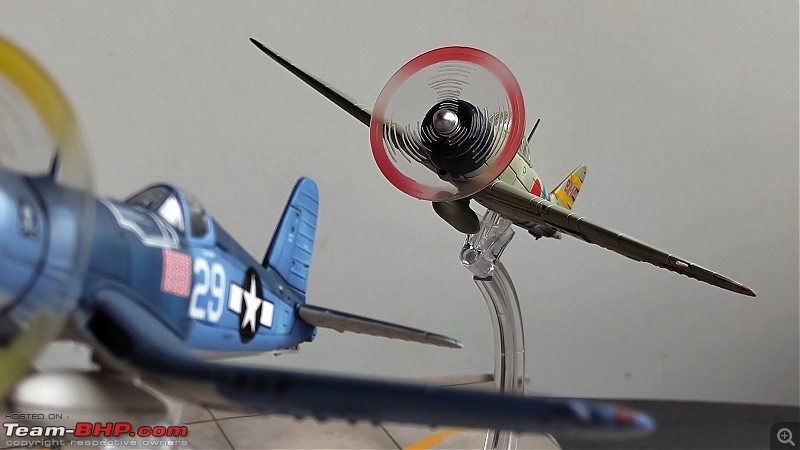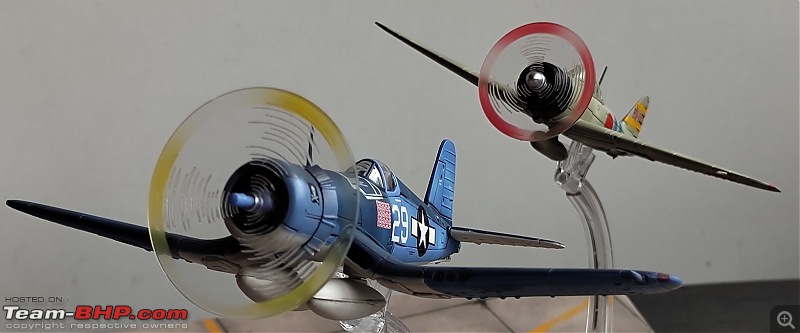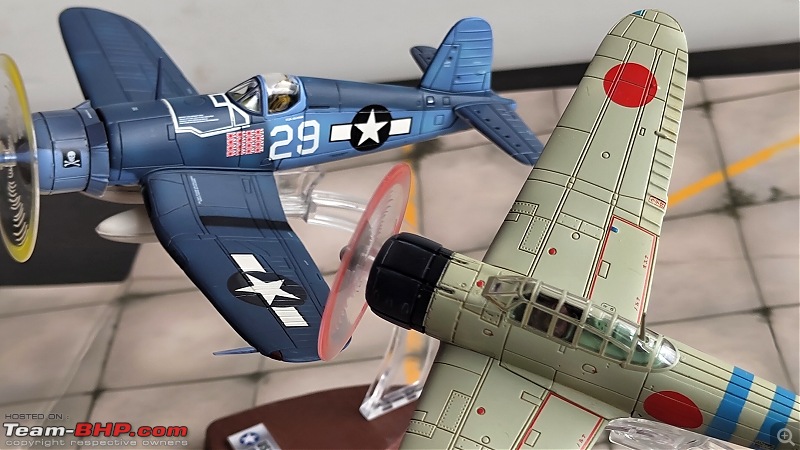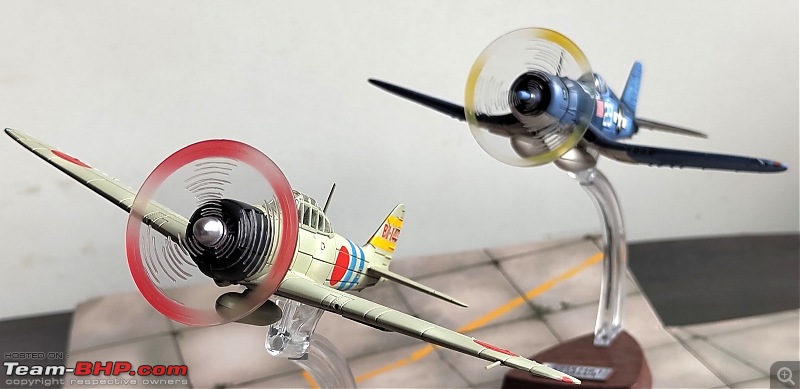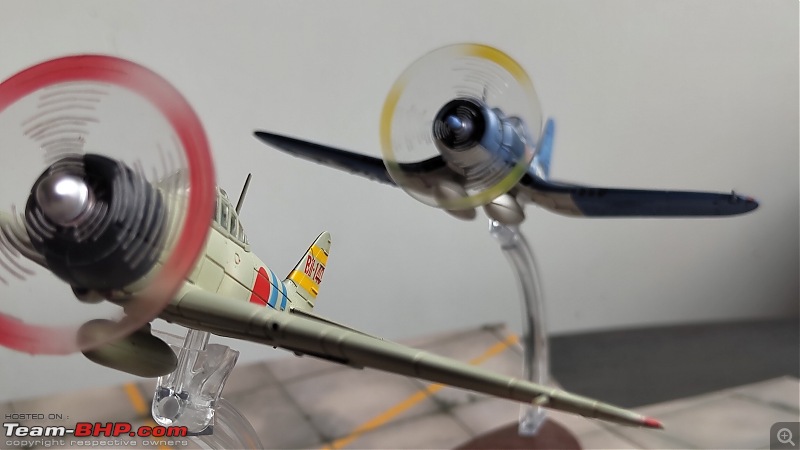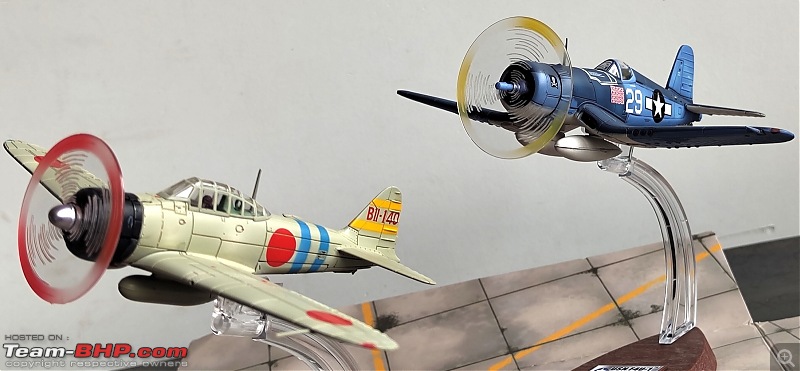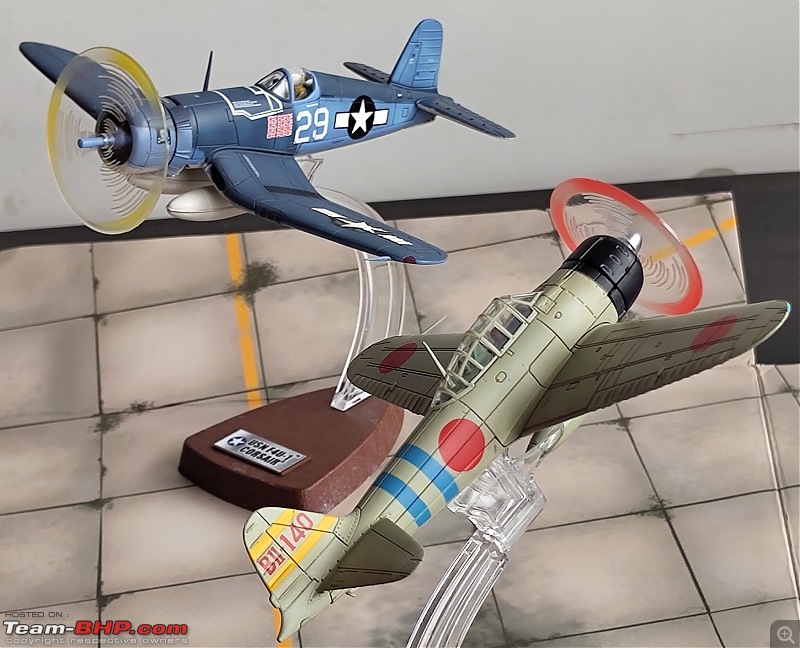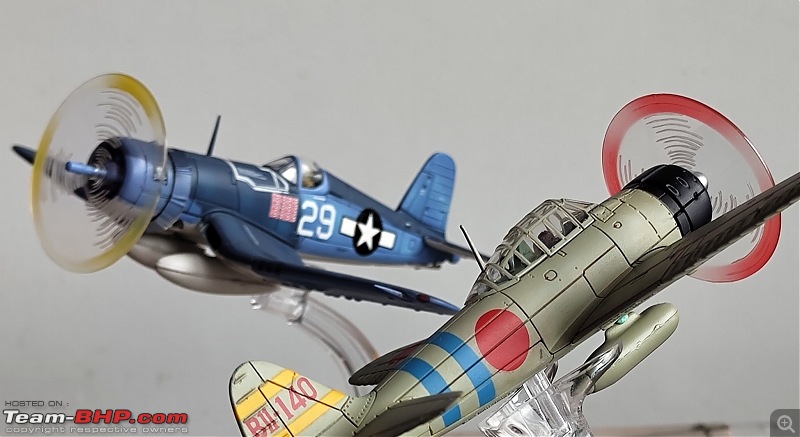| |||||||
| Search Forums |
| Advanced Search |
| Go to Page... |
 |
| Search this Thread |  693,359 views |
| | #2041 | |
| Senior - BHPian | Re: Scale Models - Aircraft, Battle Tanks & Ships Quote:
I assume this will surely be an IAF Mirage 2000H/I. Which sqdn? Last edited by skanchan95 : 11th July 2023 at 11:31. | |
| |  (2)
Thanks (2)
Thanks
 |
| The following 2 BHPians Thank skanchan95 for this useful post: | Dry Ice, Foxbat |
| |
| | #2042 |
| BHPian Join Date: Sep 2012 Location: Bombay
Posts: 714
Thanked: 1,162 Times
| Re: Scale Models - Aircraft, Battle Tanks & Ships Good evening fellow collectors, I would need a bit of advise from the esteemed members on this thread. I wanted to know how do you guys display your models at your home ? Is it in a glass cabinet ? I am worried about too much dust and damage when models are left in the open. Can you guys please post some pictures of your display cabinets , that will be very helpful for budding collectors like me in our journey. Regards Diesel |
| |  (1)
Thanks (1)
Thanks
 |
| The following BHPian Thanks Dieseltuned for this useful post: | V.Narayan |
| | #2043 | ||
| Distinguished - BHPian  Join Date: Aug 2014 Location: Delhi-NCR
Posts: 4,071
Thanked: 64,334 Times
| Re: Scale Models - Aircraft, Battle Tanks & Ships Quote:
Quote:
 | ||
| |  (9)
Thanks (9)
Thanks
 |
| The following 9 BHPians Thank V.Narayan for this useful post: | badboyscad, d.w.w., Dieseltuned, Dry Ice, Foxbat, Jeroen, libranof1987, skanchan95, Vishal.R |
| | #2044 | |
| BHPian Join Date: May 2009 Location: NYC / Lucknow
Posts: 620
Thanked: 3,548 Times
| Re: Scale Models - Aircraft, Battle Tanks & Ships Quote:
 On the box it says Mirage 2000C of the Tigers Squadron based in Gwalior. On the box it says Mirage 2000C of the Tigers Squadron based in Gwalior.No separate cabinet for the Russians?  Thats a good way to reduce the options, I would have never thought of that! | |
| |  (3)
Thanks (3)
Thanks
 |
| The following 3 BHPians Thank Foxbat for this useful post: | Dry Ice, skanchan95, V.Narayan |
| | #2045 | |
| Senior - BHPian | Re: Scale Models - Aircraft, Battle Tanks & Ships Quote:
Front view 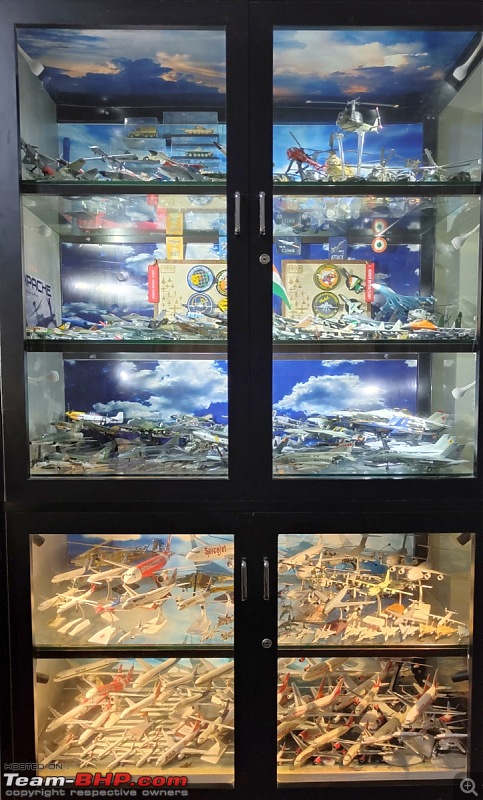 Side view 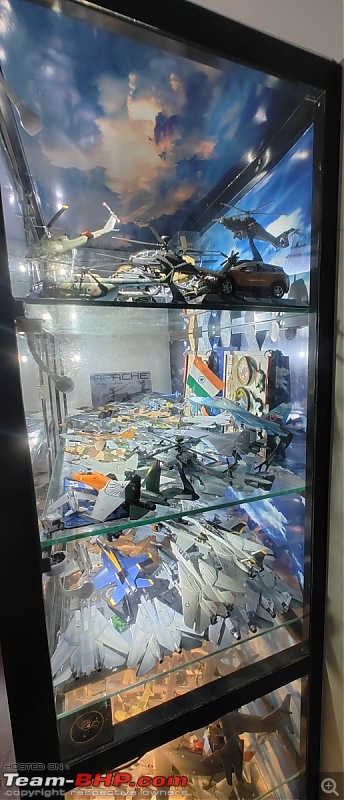 Top three shelves - Military, Bottom two - Civilian & 1:200, 400 scale military 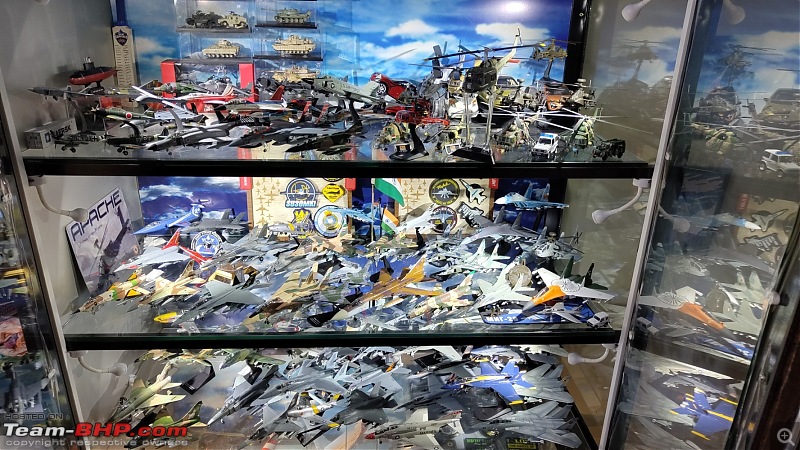 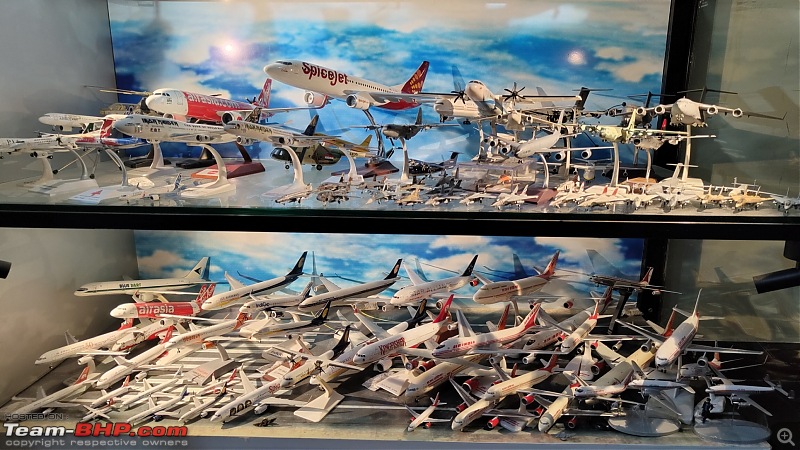 The display case was initially made using brushed aluminum outer frame with thick glass to see through, and full length glass doors to have access to the models. But there was a little gap because of which dust used to creep in. I had no option but to a frame for the glass doors made and that more or less solved the dust issue. Dust and moisture can quite damaging to these models. Direct Sunlight will cause fading & yellowing of plastic models. That's is the reason why I waited to get a cabinet built and did not keep these models on display on an open shelf. I have also kept quite a few silica gel sachets at random places on the display cabinet to keep a check on the moisture buildup inside. | |
| |  (7)
Thanks (7)
Thanks
 |
| The following 7 BHPians Thank skanchan95 for this useful post: | badboyscad, d.w.w., Dry Ice, Foxbat, libranof1987, sajands, wolg |
| | #2046 |
| Senior - BHPian | Re: Scale Models - Aircraft, Battle Tanks & Ships 1:72 Aérospatiale SA316B Alouette III Sécurité Civile(Amercom) The Aerospatiale Alouette III is a single-engine, light utility helicopter developed by French aircraft company Sud Aviation. During its production life, it proved to be a relatively popular rotorcraft; including multiple licensed manufacturers, more than 2,000 units were built. The Alouette III was such a familiar sight in Africa and African conflicts that some, only half-jokingly, called it the "Huey of Africa", after the extremely popular Bell UH-1 helicopter. The Alouette III was principally manufactured by Aerospatiale; the type was also built under licence by Hindustan Aeronautics Limited (HAL) in India as the HAL Chetak, by Industria Aeronautica Romana (IAR) in Romania as the IAR 316 and F+W Emmen in Switzerland. The Alouette III was used to perform missions such as aerial observation, photography, air-sea rescue, liaison, transport and training; it could also be armed with anti-tank missiles, anti-shipping torpedoes, and a fixed cannon. In a civilian capacity, the Alouette III was commonly used for casualty evacuation (often fitted with a pair of external stretcher panniers), crop-spraying, personnel transportation, and for carrying external loads. The HAL Chetak Under a licensing arrangement between Aerospatiale and Hindustan Aeronautics Limited (HAL), the Alouette III had been built under licence by HAL in India. Known locally under the designation HAL Chetak, more than 300 rotorcraft have been manufactured to date; the majority of these were acquired for military purposes with the Indian Armed Forces, who have used them to perform various mission roles, including training, transport, CASEVAC (casualty evacuation), communications and liaison roles. In 1986, the Indian Government constituted the Army's Aviation Corps; consequently, the majority of Chetaks previously operated by AOP Squadrons were transferred from the Indian Air Force to the Indian Army on 1 November 1986. The Air Force has continued to fly a force of armed Chetaks in the anti-tank role as well as for CASEVAC missions and general duties. During the 2010s, the Chetak is being gradually replaced by the newer HAL Dhruv in the armed forces. An option to re-engine the HAL Chetak with the Turbomeca TM 333-2B engine, which would better facilitate high-altitude operations in the Himalayas was considered, but ultimately not pursued. In addition to producing the type for Indian customers, HAL has also achieved some export sales of Chetak helicopters to several nations, including Namibia and Suriname. India has also opted to donate several secondhand Chetak helicopters to other countries, such as neighbouring Nepal. HAL Chetak was used in Operation Khukri which was a multinational operation launched in the United Nations Assistance Mission in Sierra Leone (UNAMSIL), involving India, Ghana, Britain and Nigeria. Beginning in the 1970s, during Republic Day parades, Chetak helicopters have been decorated to look like animals such as dodo birds, fish, and, most notably, elephants. The helicopters decorated like elephants have become iconic in India, and known as names such as "dancing elephant helicopters" and "flying elephants". General characteristics Crew: 2 Capacity: 5 passengers Length: 10.03 m (32 ft 11 in) Height: 3 m (9 ft 10 in) Empty weight: 1,143 kg (2,520 lb) Gross weight: 2,200 kg (4,850 lb) Powerplant: 1 × Turbomeca Artouste IIIB turboshaft, 649 kW (870 hp) derated to 425 kW (570 hp) Main rotor diameter: 11.02 m (36 ft 2 in) Main rotor area: 95.38 m2 (1,026.7 sq ft) Performance Maximum speed: 210 km/h (130 mph, 110 kn) at sea level Cruise speed: 185 km/h (115 mph, 100 kn) Range: 540 km (340 mi, 290 nmi) Service ceiling: 3,200 m (10,500 ft) Rate of climb: 4.3 m/s (850 ft/min) Not the best looking helicopter models out there and it has not so great detailing, but it is the only decent looking diecast Alouette III ever manufactured 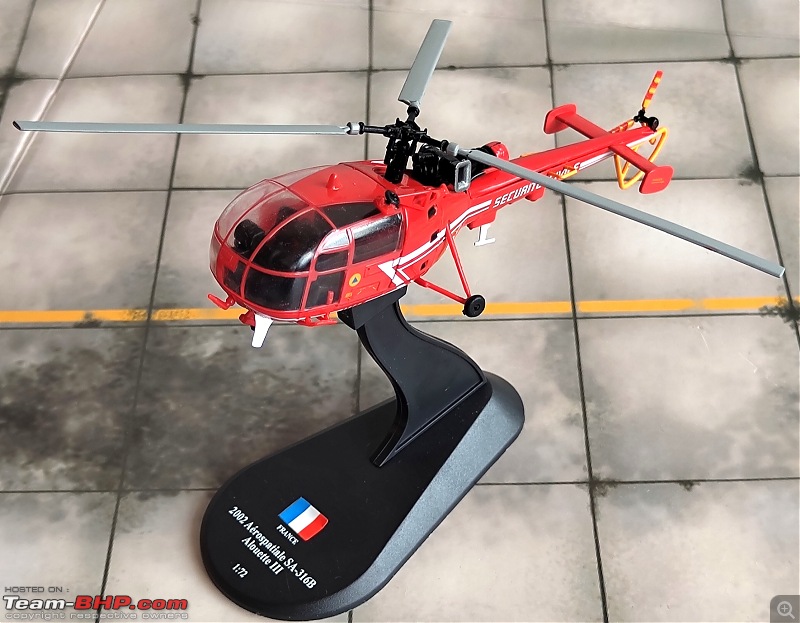 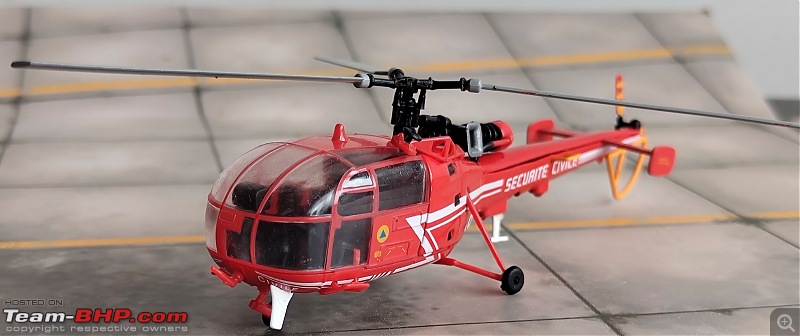 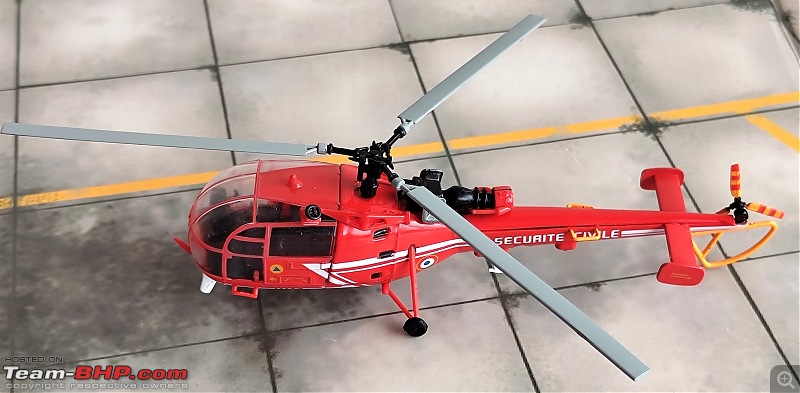 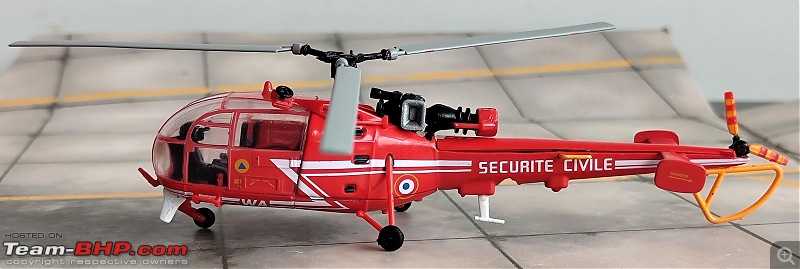 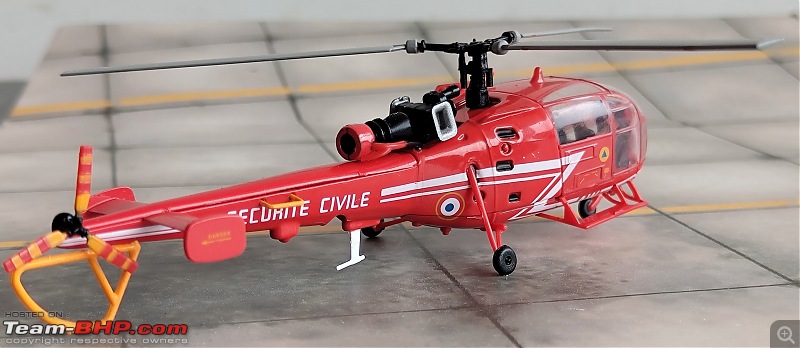 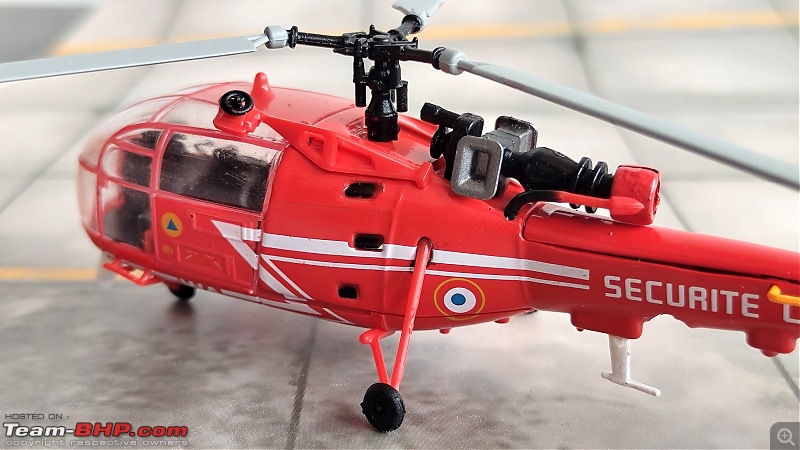 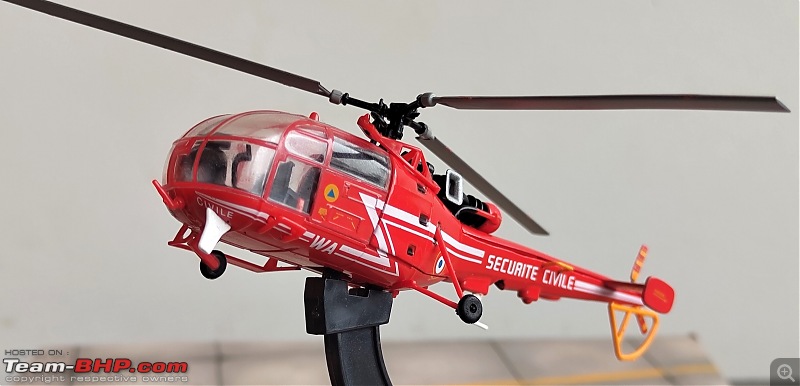 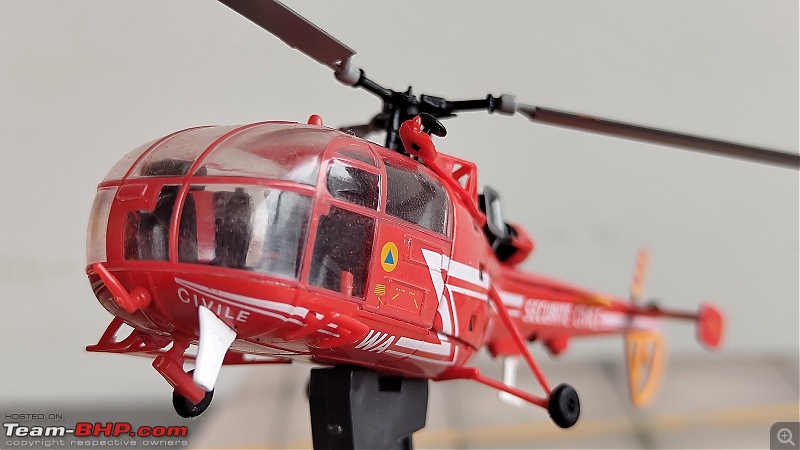 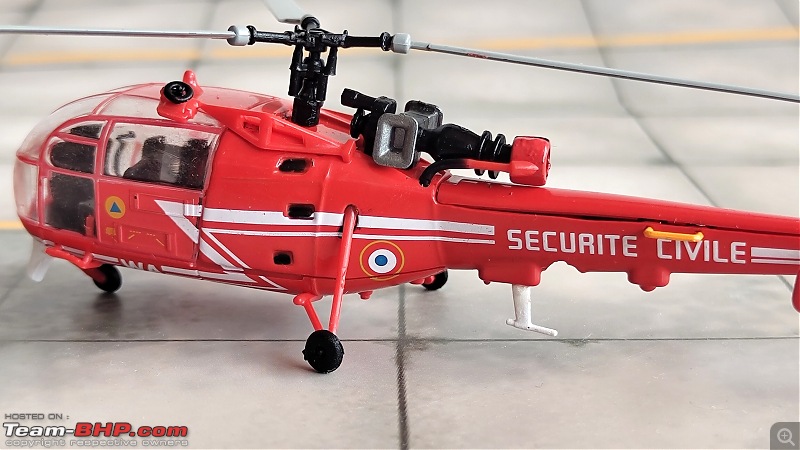 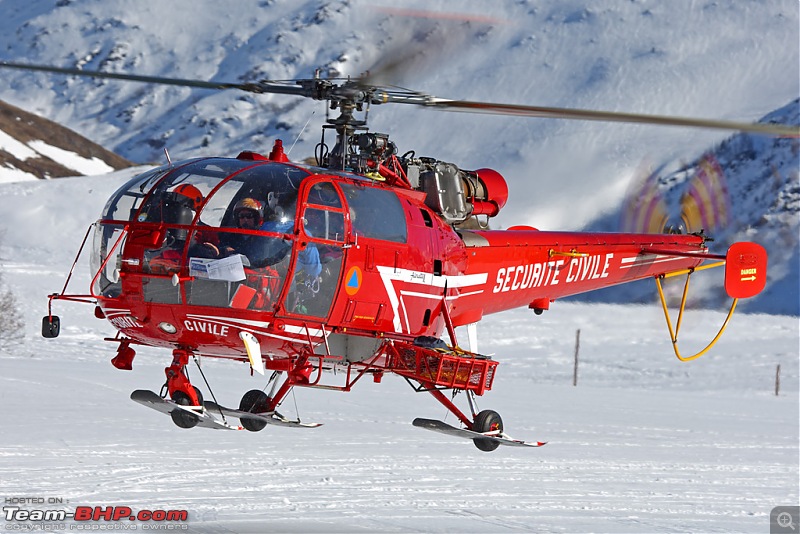 Last edited by skanchan95 : 19th July 2023 at 15:37. |
| |  (6)
Thanks (6)
Thanks
 |
| The following 6 BHPians Thank skanchan95 for this useful post: | badboyscad, d.w.w., Dry Ice, Foxbat, libranof1987, V.Narayan |
| | #2047 |
| Distinguished - BHPian  | Re: Scale Models - Aircraft, Battle Tanks & Ships I happen to find myself at the AviationMegastore near Schiphol Amsterdam airport earlier this week. Noticed a whole section with books about the IAF (see my other posts). I also came across this modelkit. I bought it on the spot. I always wanted to have one of these. There are not many of these around. 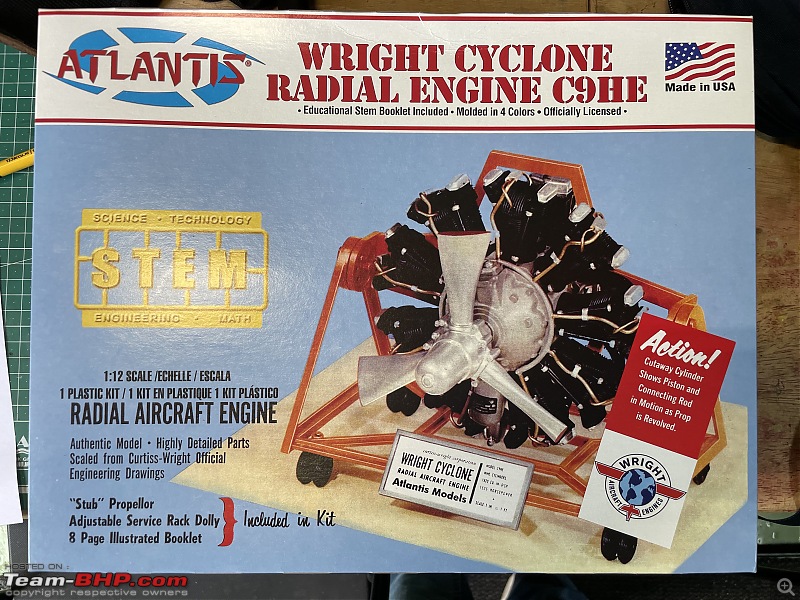 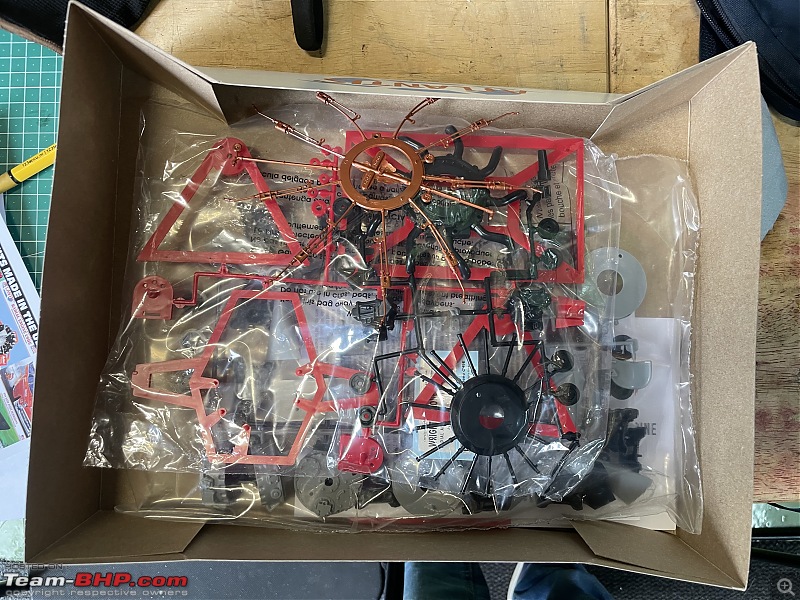 I find these radial engines absolutely fascinating. Will be fun putting it together! Jeroen |
| |  (5)
Thanks (5)
Thanks
 |
| The following 5 BHPians Thank Jeroen for this useful post: | badboyscad, d.w.w., Dry Ice, skanchan95, V.Narayan |
| | #2048 |
| Senior - BHPian | Re: Scale Models - Aircraft, Battle Tanks & Ships 1:144 Fairchild Republic A-10A Thunderbolt II 81-0994 USAF 127th Fighter Wing, 107th Fighter Sqdn "Red Devils", Michigan Air National Guard, 100th Anniversary 2017 (JC Wings) Except for the popular warthog and cobra nose arts, A-10s rarely carried any special color schemes. One exception is this A-10A of the Michigan Air National Guard that received this historic paint scheme and an over-sized version of the red devil from the unit's badge to commemorate the 100th anniversary of the 107th Squadron. The D-Day Invasion stripes, applied to this A-10A to celebrate the 100th anniversary the squadron . The paint job is inspired from the P-51s of then 107th TRS, that flew the Mustang over Normandy during WWII. 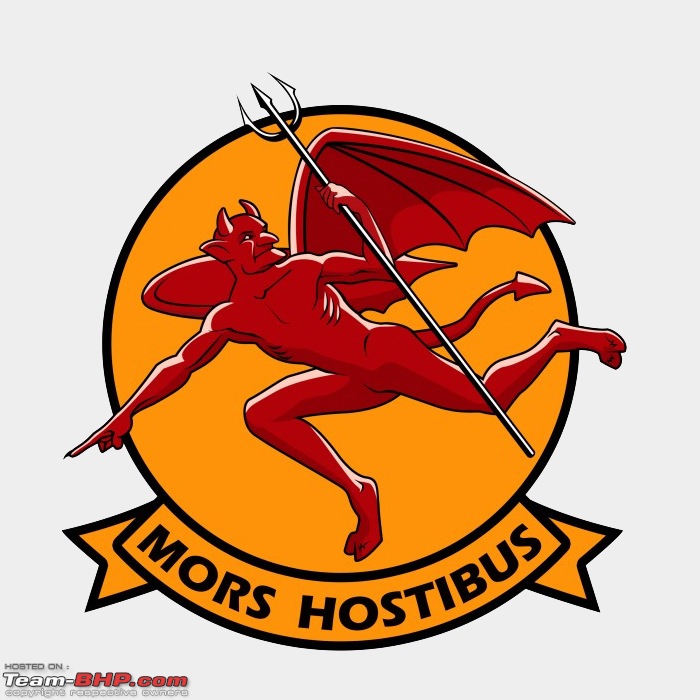 A Red Devil and the Latin phrase “Mors Hostibus” – Death to the Enemy – is the unit insignia and motto of the 107th Fighter Squadron. The 107th Fighter Squadron "Red Devils" is a unit of the Michigan Air National Guard 127th Wing. It is assigned to Selfridge Air National Guard Base, Michigan and is equipped with the Fairchild Republic A-10 Thunderbolt II aircraft. The 107th Fighter Squadron is one of the US's oldest squadrons tracing it’s beginnings as the 107th Aero Squadron formed at Kelly Field, Texas in August 1917. Designed to counter criticism that the US Air Force wasn't serious enough about close air support, the A-10 Thunderbolt II was first flown on May 10, 1972. The Thunderbolt II is a single-seat attack aircraft used to protect ground forces from tanks, armored vehicles and other ground targets. Nicknamed "Warthog," the A-10 is highly maneuverable at low speeds and low altitude and is capable of short take-offs and landings. It is designed for easy maintenance-many of its parts are interchangeable between the right and left side and it can operate from bases with limited facilities. The A-10 is expected to remain in service until 2028 or beyond 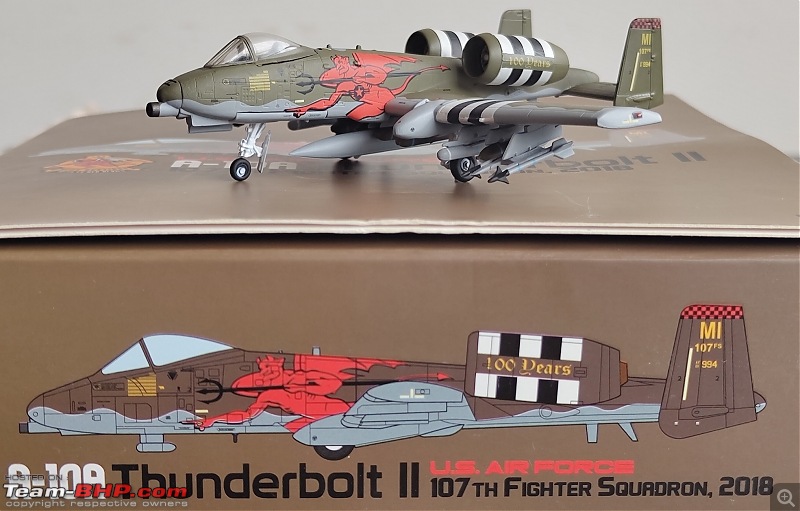 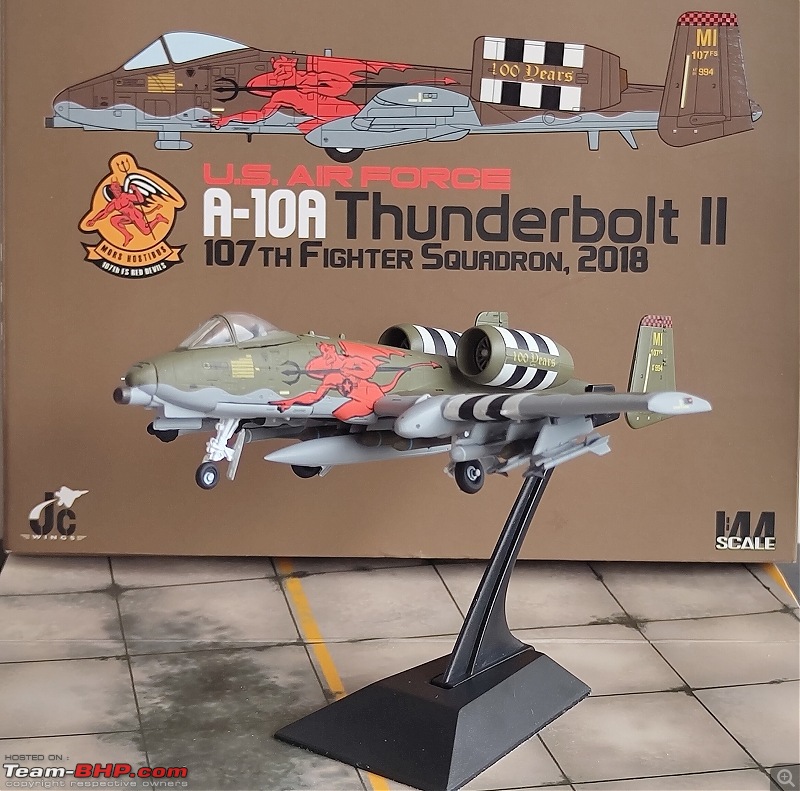 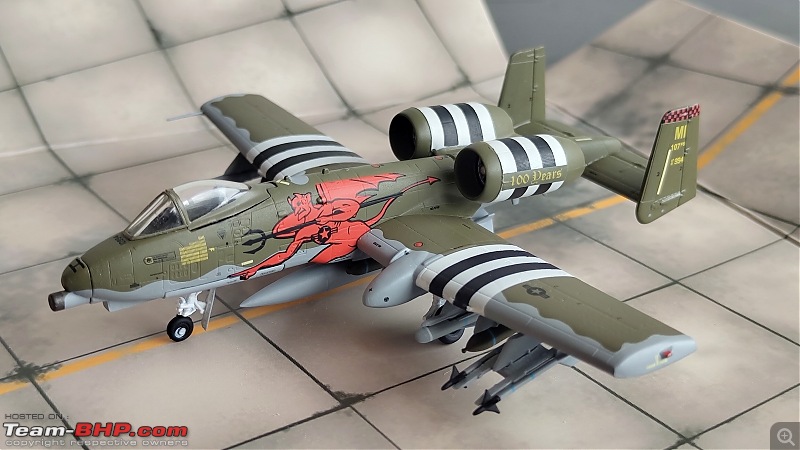 An intriguing thing about the kill marks painted on the aircraft is that it carries a Cow kill mark which means this A-10 Warthog BRRRRTTTTed a Cow during a CAS Mission. The pilot of this A-10 said he was performing a Close Air Support (CAS) sortie when he inadvertently killed a cow during aerial operations during the 107th Sqdn’s deployment to Iraq. The A-10s of 107th sqdn had deployed to Iraq and Syria in April 2015 as part of Operation Inherent Resolve, the U.S.-led fight against the Islamic State group’s caliphate there. 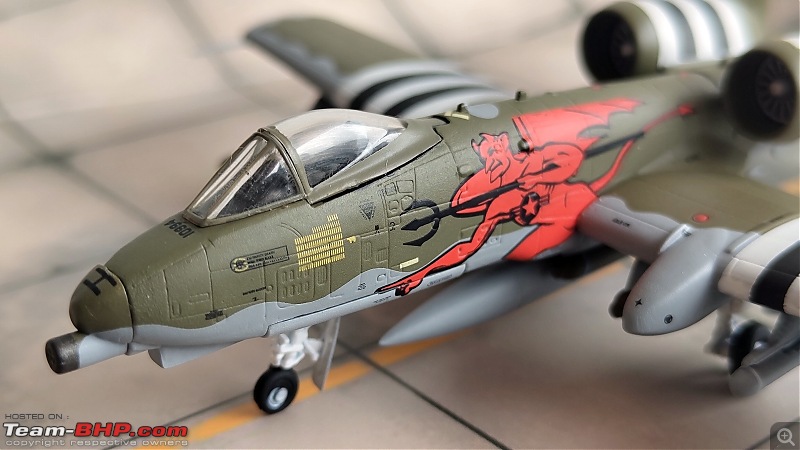 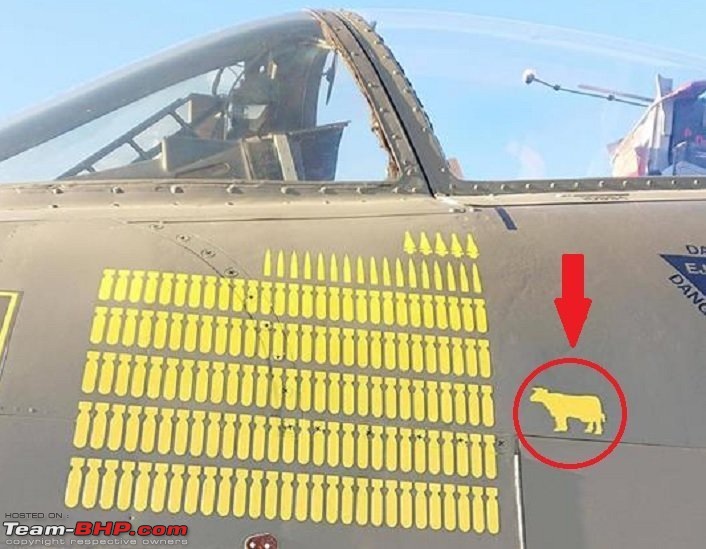 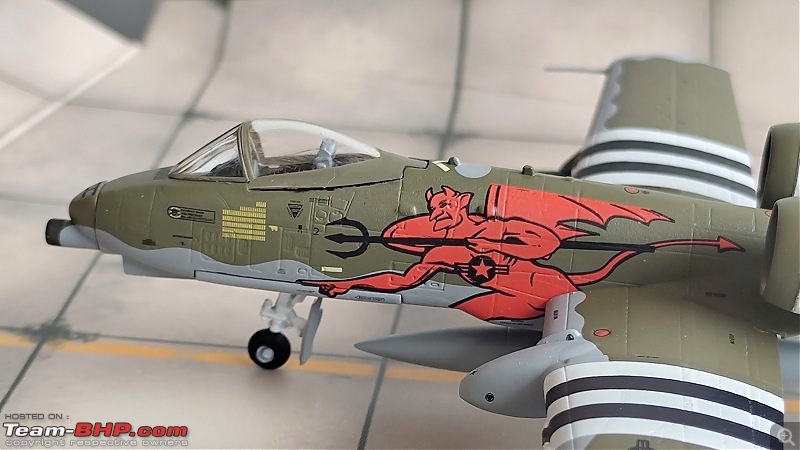 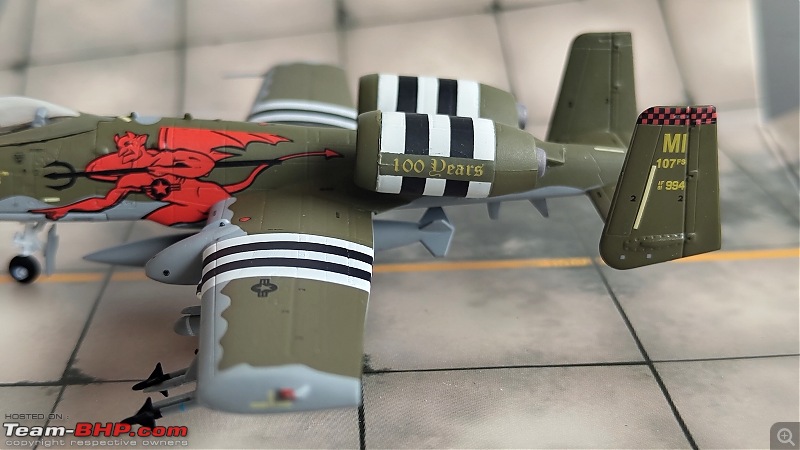 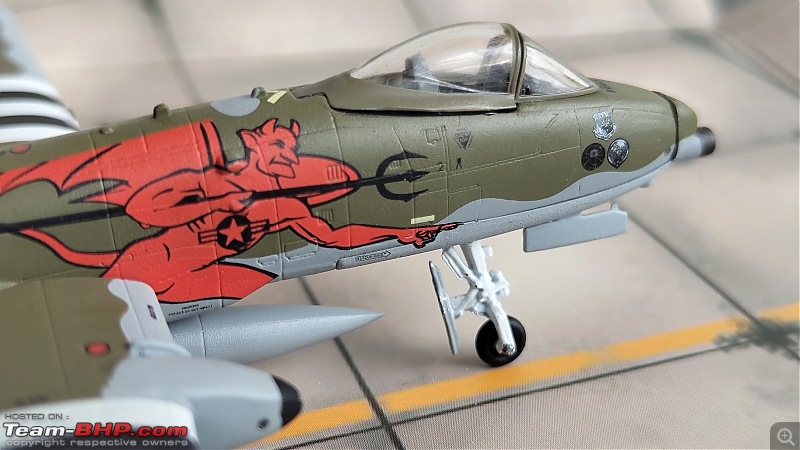 Devil's Trident artwork on the underside 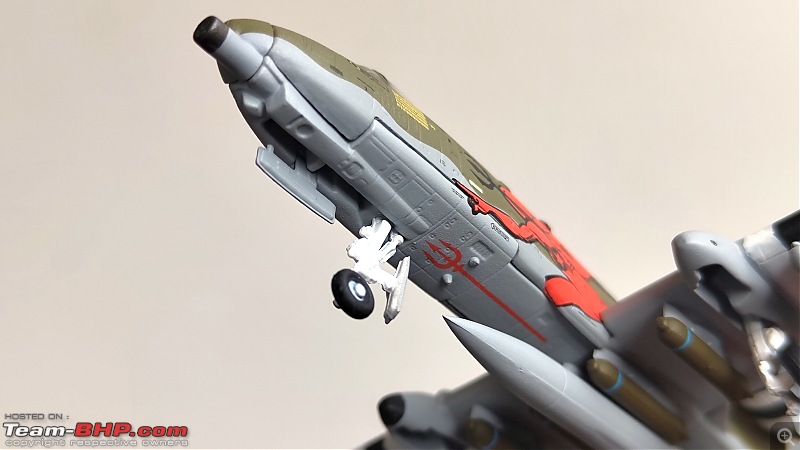 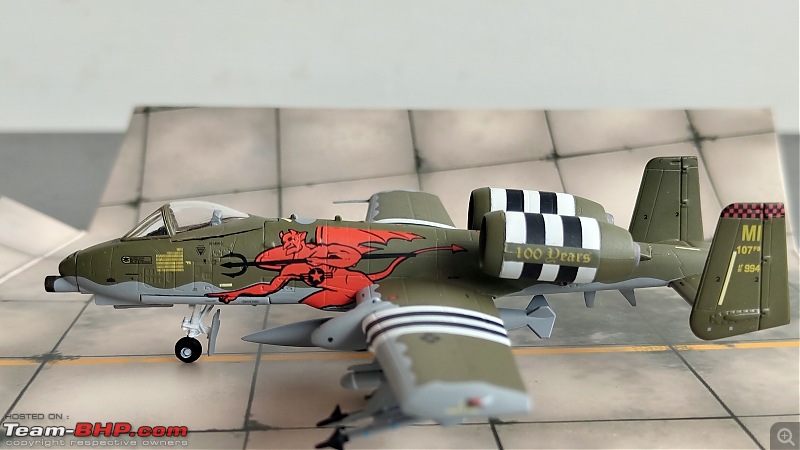 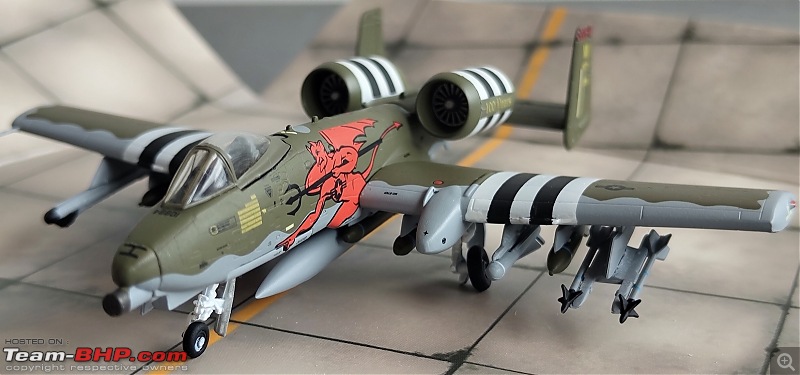 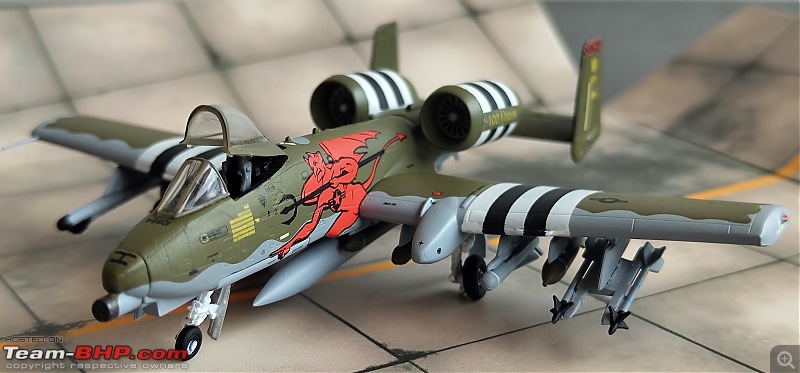 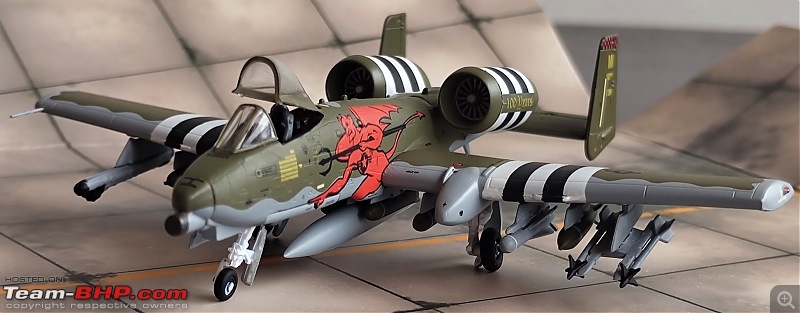 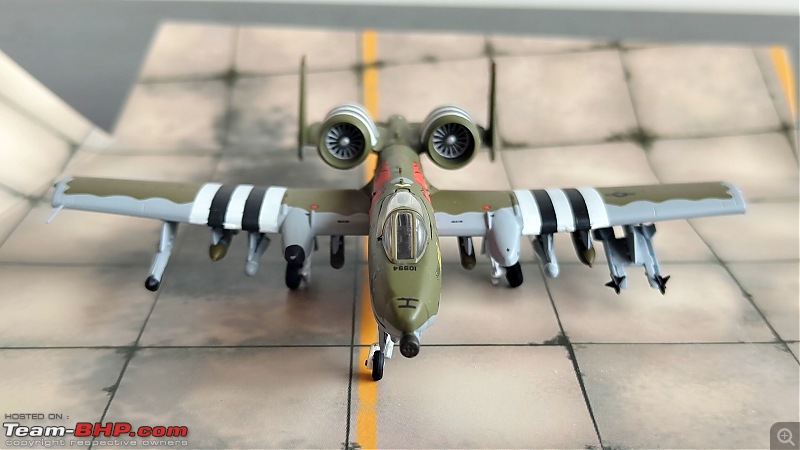 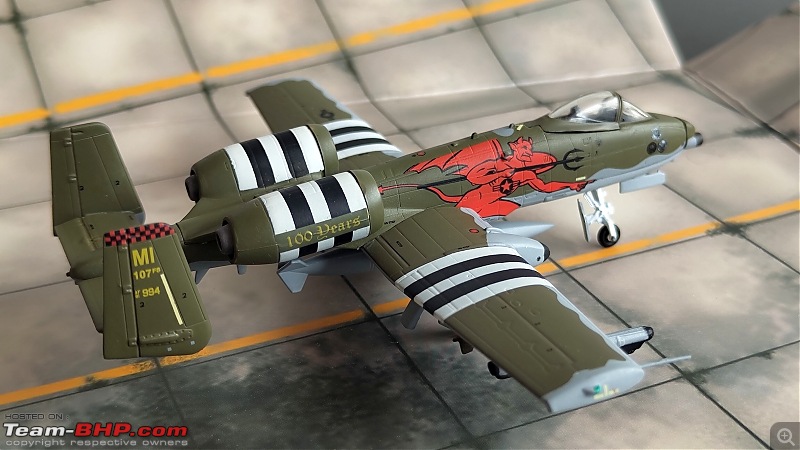 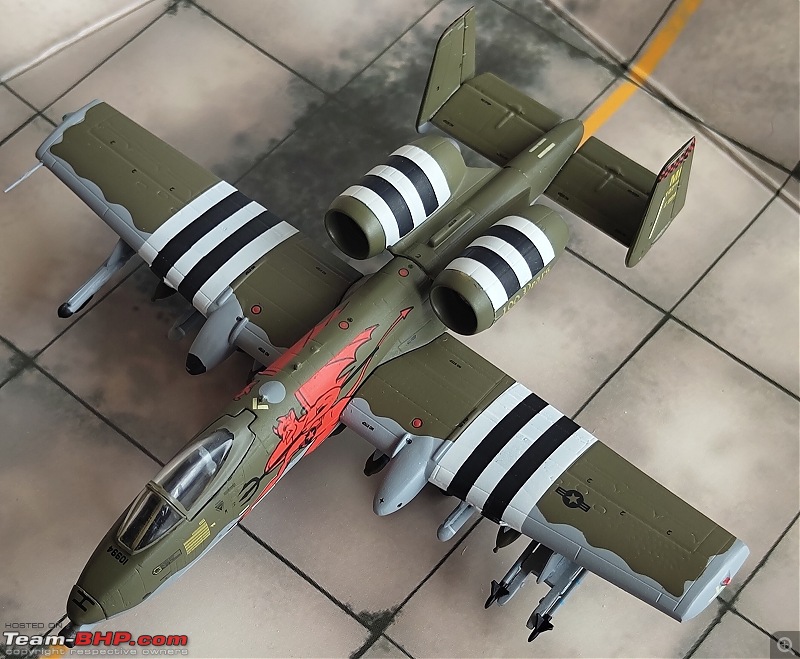 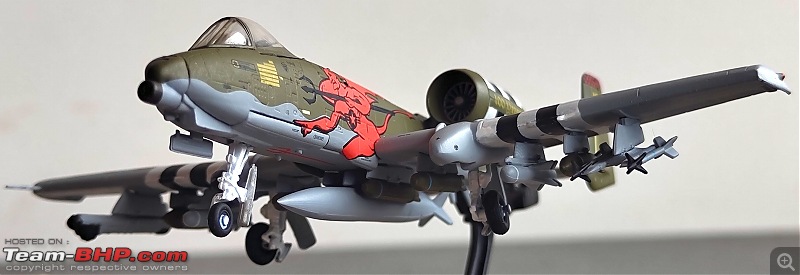 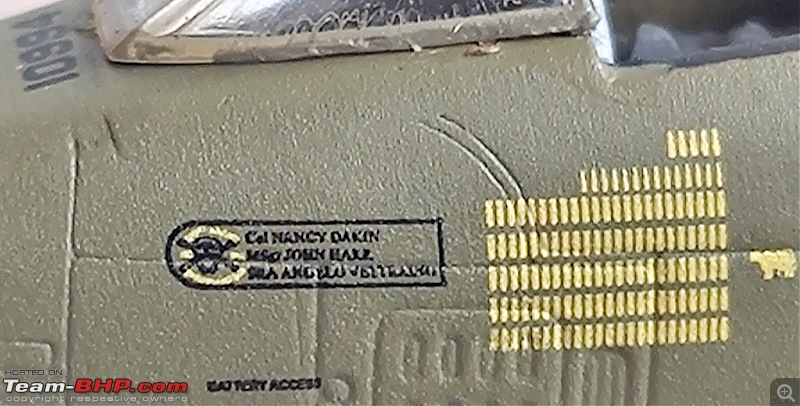 Pilot Name - Col. Nancy Dakin - Commanding Officer, 127th FW, 2018 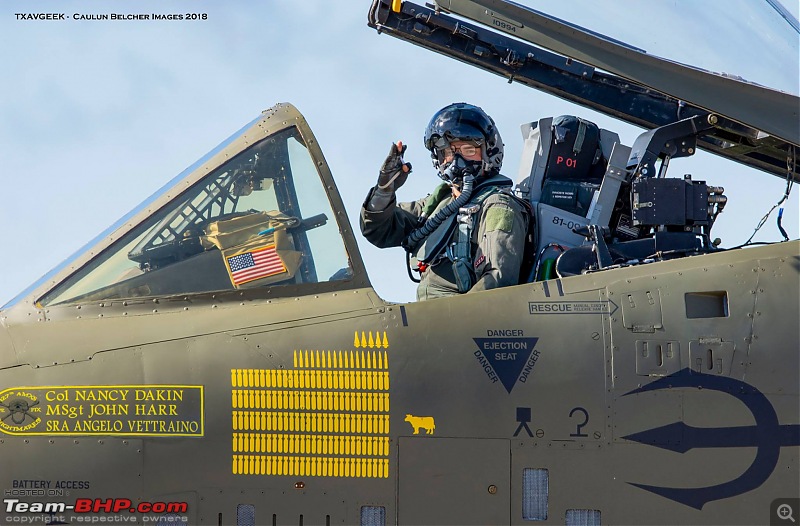 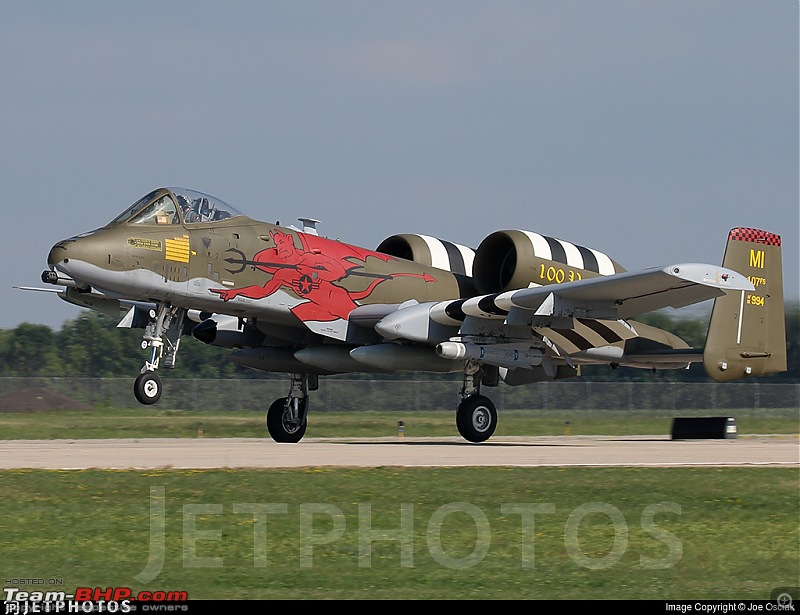 Last edited by skanchan95 : 21st July 2023 at 12:37. |
| |  (6)
Thanks (6)
Thanks
 |
| The following 6 BHPians Thank skanchan95 for this useful post: | badboyscad, Dry Ice, Foxbat, Jeroen, libranof1987, V.Narayan |
| | #2049 | ||
| Distinguished - BHPian  Join Date: Aug 2014 Location: Delhi-NCR
Posts: 4,071
Thanked: 64,334 Times
| Re: Scale Models - Aircraft, Battle Tanks & Ships Quote:
 Another masterpiece added to your collection. Even though it is a 1:144 your photography does it a lot of credit. The A-10 like the Su-25 flies very real close air support missions. I once asked a Army officer leading a wing of close support helicopter squadrons why these two aircraft had not found favour they, IMHO, deserved. His answer was the proliferation of MANPADs that makes operating slow and low a suicide mission against a well armed and organized adversary. Helicopters can at least hide behind terrain - even then they are very vulnerable except in the night. This is one US aircraft I have my sights set on. Quote:
 An eternal design. The French really do know how to design helicopters. Those engines are embarrassingly reliable!! I wonder why we ignored the TM333 powered Aloutte III. We married it to the same old rotor and didn't upgrade it. I guess it may have been the old excuse - if the Dhruv is around the corner why do this - budgets don't allow it - and then the Dhruv got delayed several years as expected. Last edited by V.Narayan : 21st July 2023 at 13:40. | ||
| |  (2)
Thanks (2)
Thanks
 |
| The following 2 BHPians Thank V.Narayan for this useful post: | libranof1987, skanchan95 |
| | #2050 |
| BHPian Join Date: Mar 2016 Location: Palakkad
Posts: 608
Thanked: 1,382 Times
| Re: Scale Models - Aircraft, Battle Tanks & Ships Having seen the Warthog in various videos. The recent video in Real Engineering and the comments in the video made me realise the cult following behind this plane. The comments on this video are very interesting read. |
| |  (1)
Thanks (1)
Thanks
 |
| The following BHPian Thanks rohitoasis for this useful post: | V.Narayan |
| | #2051 | ||
| Senior - BHPian | Re: Scale Models - Aircraft, Battle Tanks & Ships Quote:
Yes, chivalrous is the one word to describe around attack pilots , especially those flying CAS missions. At times, they go beyond the call of duty to do whatever it takes to help their comrades on the ground. Quote:
The legendary Skull'n Bones tail and livery is probably the most famous and easily recognizable liveries ever painted on a Tomcat. The "original" Jolly Rogers F-14A AJ/200 160393 was seen in the movie The Final Countdown firing an AIM-9 at an IJN Mitsubishi Zero.* Find it weird? It was because it was a 1980 science fiction war film about USS Nimitz and it's airwing that travels through time to the day before the December 7, 1941, attack on Pearl Harbor. The movie was known for its absolutely brilliant aerial videography. * I say original because after VF-84 was de-established in the mid-1990s, VF-103 "Sluggers" inherited the Jolly Rogers legacy and livery & were re-named as Jolly Rogers. 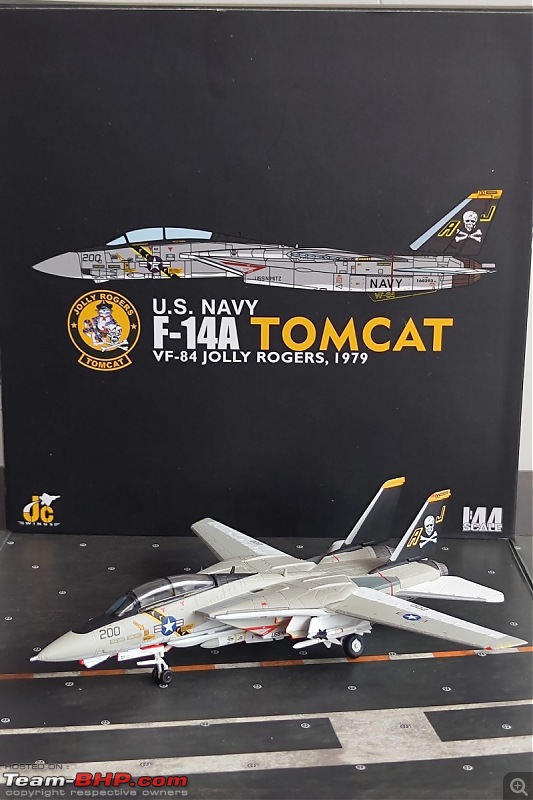 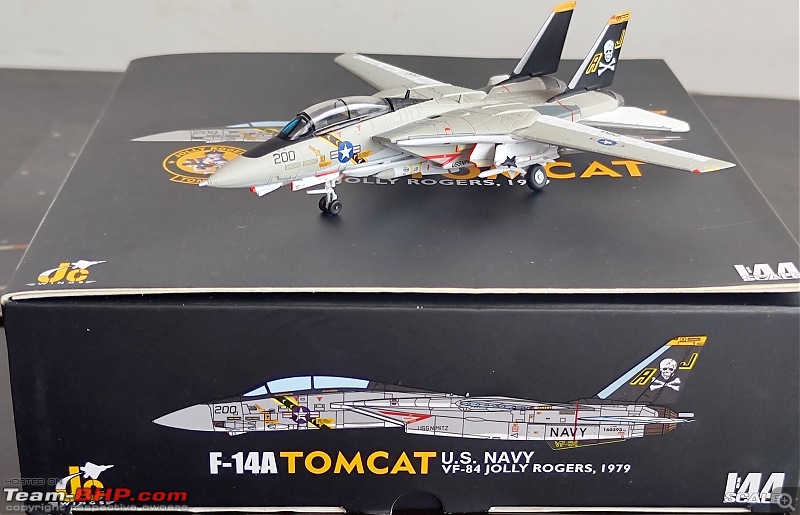 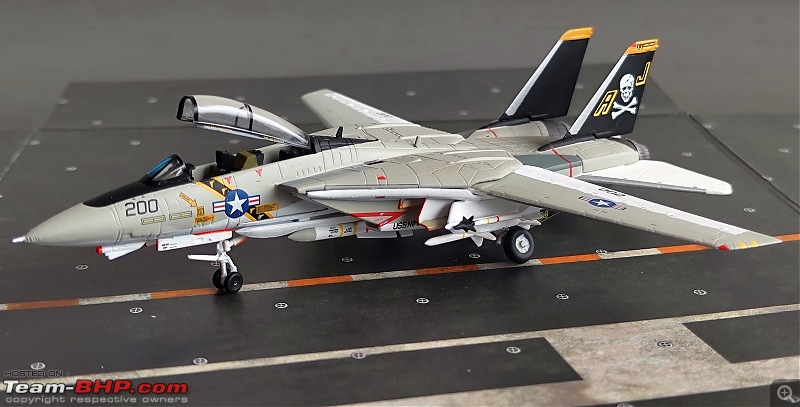 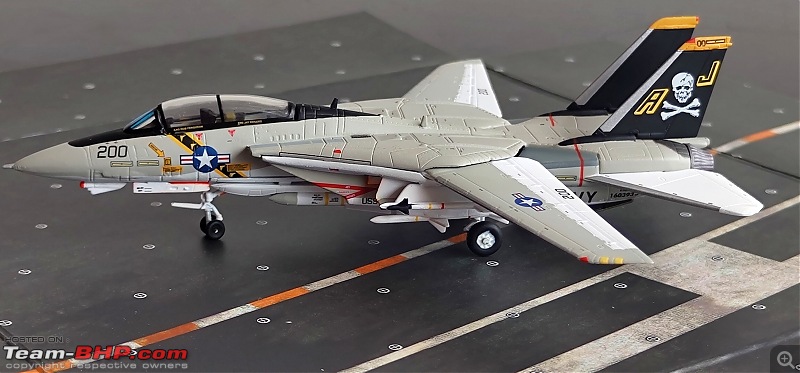 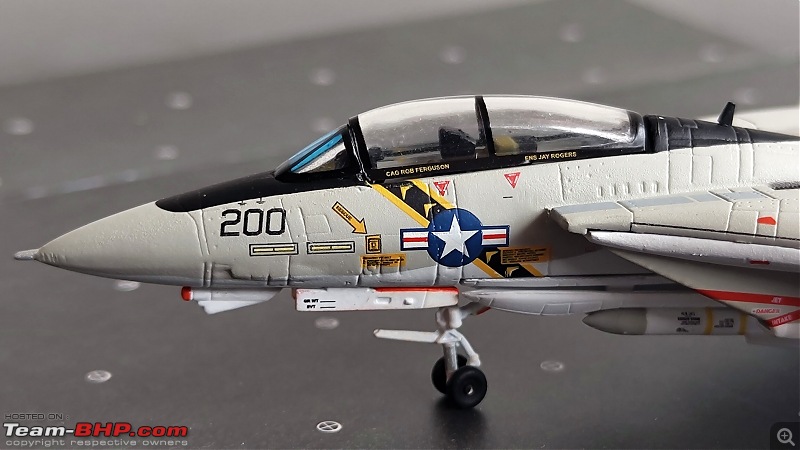 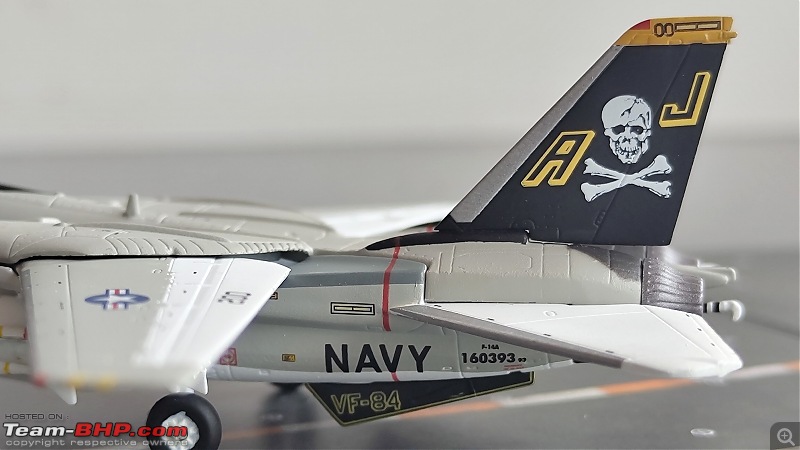 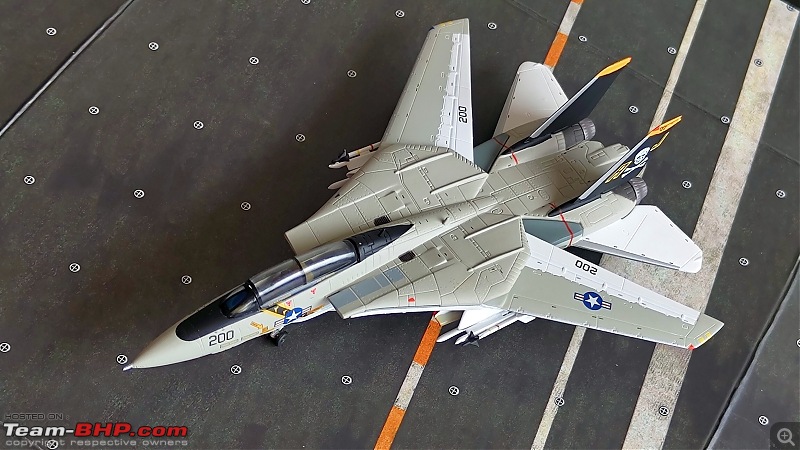 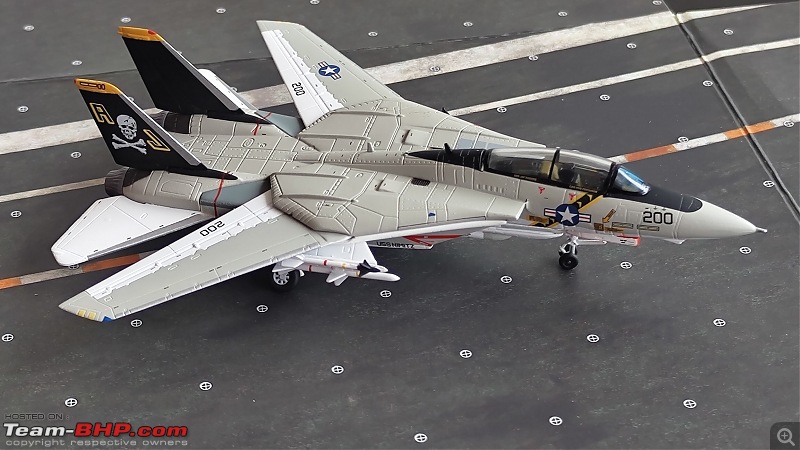 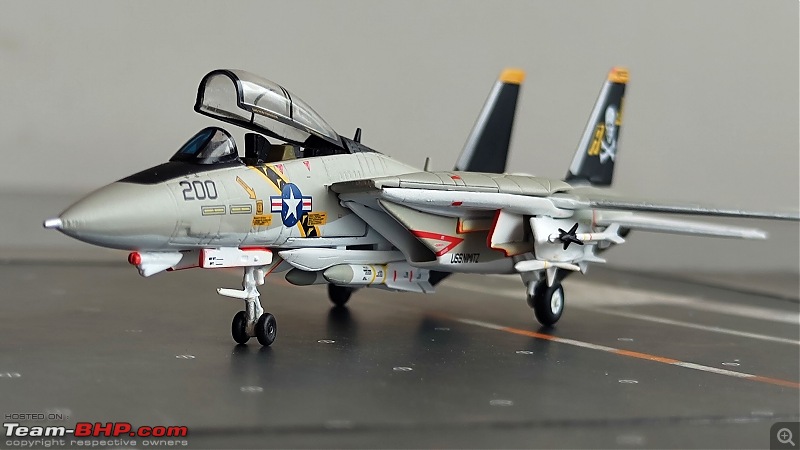 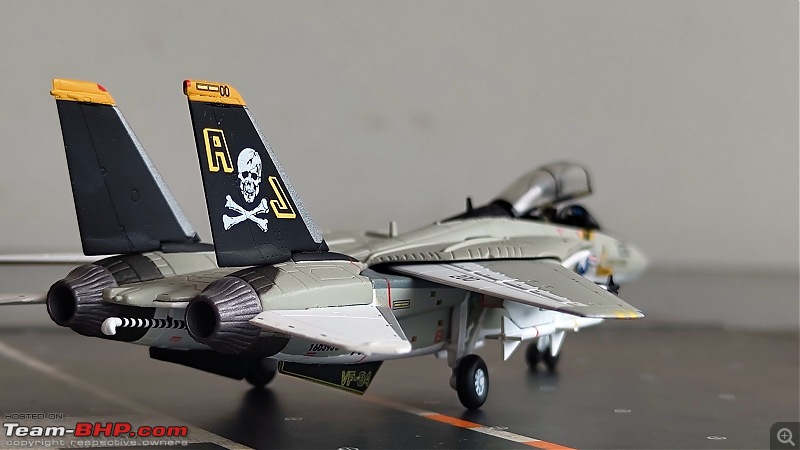 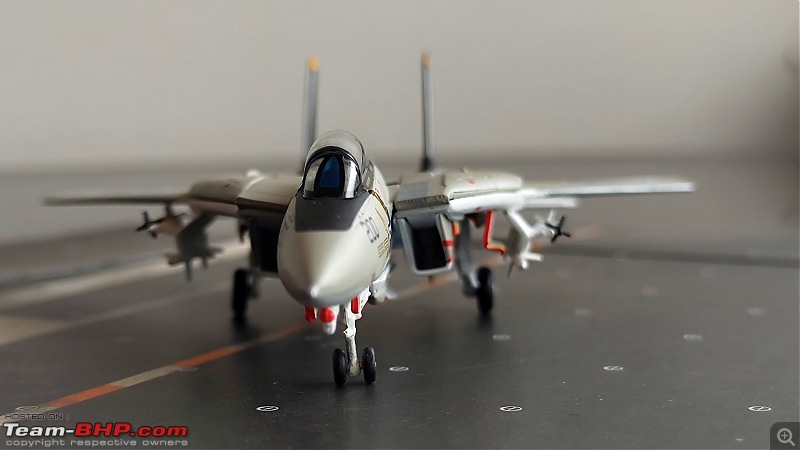 Victory 2-0-0 Wave Off!!! Wave Off!!! 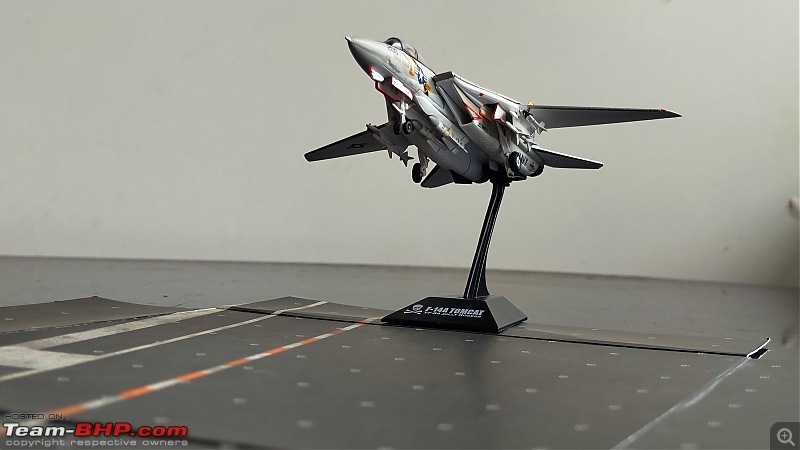 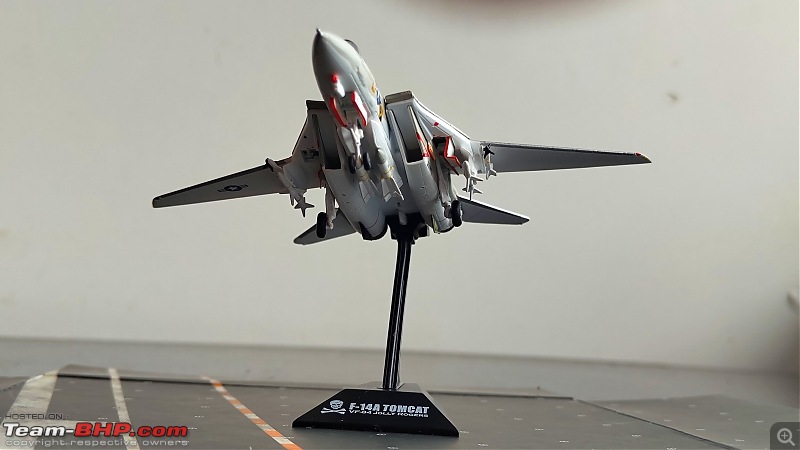 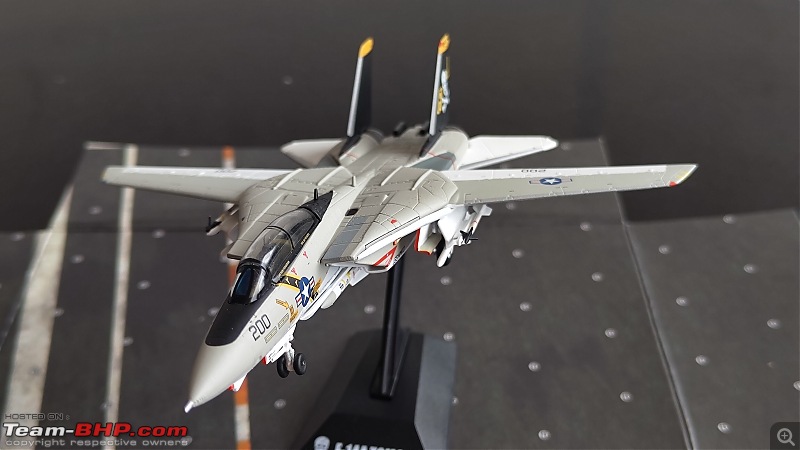 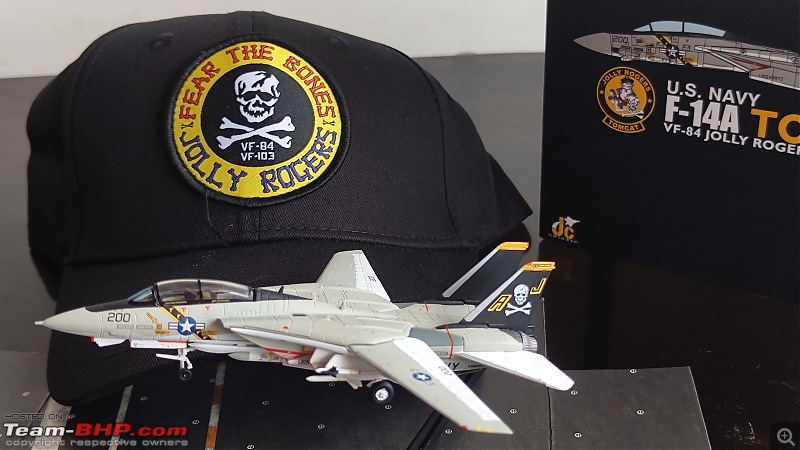  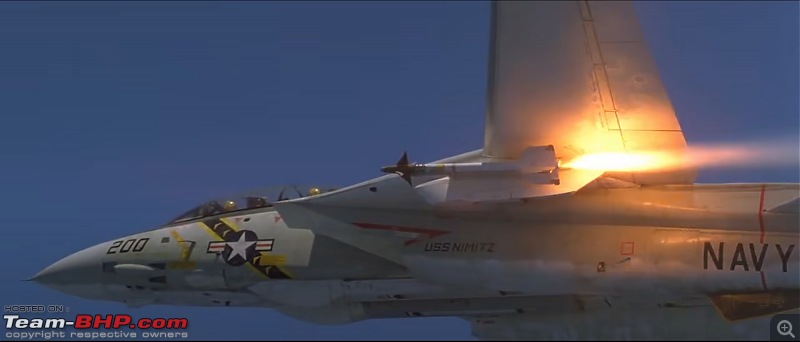 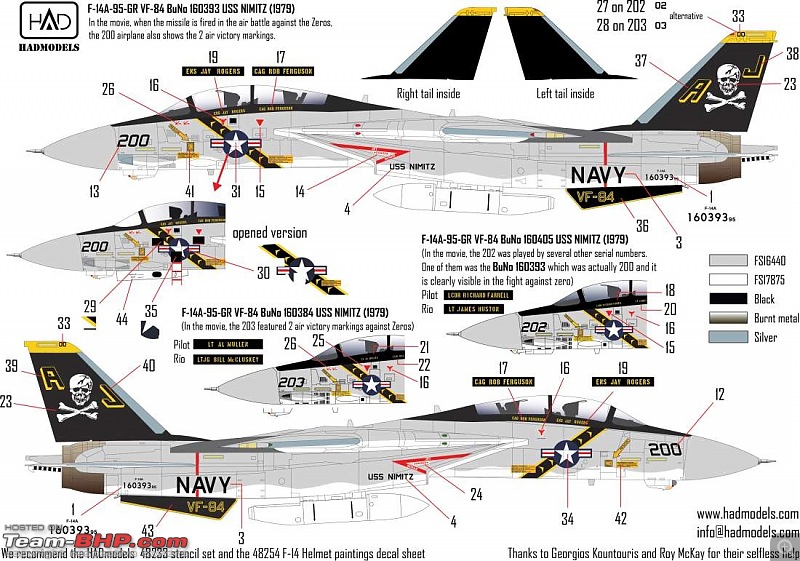 Last edited by skanchan95 : 24th July 2023 at 12:25. | ||
| |  (3)
Thanks (3)
Thanks
 |
| The following 3 BHPians Thank skanchan95 for this useful post: | badboyscad, Foxbat, V.Narayan |
| |
| | #2052 |
| Senior - BHPian | Re: Scale Models - Aircraft, Battle Tanks & Ships 1:72 Mitsubishi A6M2 "Zero" Lt. Sumio Nouno, 11th Section, 4th Hikotai, IJN Carrier Hiryu, Pearl Harbor Attack, Hawaii, December 1941 The Mitsubishi A6M Zero was a carrier based fighter used by the Imperial Japanese Navy Air Service (IJNAS) from 1940 until 1945. The origin of its official designation was that "A" signified a fighter and "6" for the sixth model built by Mitsubishi "M". The A6M is usually known as the "Zero" from its Japanese Navy type designation, Type 0 carrier fighter, taken from the last digit of the Imperial year 2600 (1940) when it entered service. In Japan, it was unofficially referred to as both Rei-sen and Zero-sen; Japanese pilots most commonly called it Zero-sen, where sen is the first syllable of sentoki, Japanese for "fighter plane". The A6M was usually referred to by the Allies as the "Zero”. First flown in April, 1939, the A6M Zero-Sen was the Allies' main opponent in the Pacific and the most famous symbol of Japanese air power during World War II. Aside from the early-morning raid on Pearl Harbor on December 7th, 1941, perhaps the biggest shock for American forces in the Pacific was the outstanding performance of the Imperial Navy's main carrier fighter, the beautifully proportioned Mitsubishi A6M2 Zero-Sen. Some 10,500 Zeros were built by Mitsubishi in no fewer than eight different sub-types, and although outclassed by more powerful US fighters from late 1943 onwards, the Zero retained a great degree of combatibility due to its weight. It had a light airframe, no armor, and it had a tremendous climb rate. The Zero had a fairly high-lift, low-speed wing with very low wing loading. Combined with its light weight, this resulted in a very low stall speed of well below 60knots/110 kmph. This was the main reason for its phenomenal maneuverability, allowing it to out-turn any Allied fighter of the time. Entering combat service in 1940, the Zero quickly gained a fearsome reputation. Thanks to a combination of unsurpassed maneuverability—compared to contemporary Axis fighters—and excellent firepower, it easily disposed of Allied aircraft sent against it in the Pacific in 1941.It proved a difficult opponent even for the Supermarine Spitfire. Although not as fast as the British fighter, the Zero could out-turn the Spitfire with ease, sustain a climb at a very steep angle, and stay in the air for three times as long. When the Lockheed P-38 Lightning, the Grumman F6F Hellcat and Vought F4U Corsair appeared in the Pacific theater, which had 1,500 - 2,000hp engines and were faster, more heavily armed, the Japanese Zero was still using engines half of that power, and was slower and inferior in most respects. In combat with an F6F or F4U, the only positive thing that could be said of the Zero at this stage of the war was that, in the hands of a skillful pilot, it could maneuver as well or even out-maneuver most of its opponents. Nonetheless, in competent hands, the Zero could still be deadly. Because of shortages of high-powered aviation engines and problems with planned successor models, the Zero remained in production until 1945, with over 10,000 of all variants produced. The Hiryu's "Swan Song" - In May 1942, the Japanese aircraft carrier Hiryu was part of the Second Carrier Division alongwith the carrier Soryu and was the flagship of the the divison's Commander Rear Admiral Tamon Yamaguchi. Her aircraft complement consisted of 21 Mitsubishi A6M "Zero" fighters, 21 Aichi D3A "Val" dive bombers, and 21 Nakajima B5N "Kate" torpedo bombers. On June 4th, 1942, she took part in the Battle of Midway. At 4:30 AM she launched a strike against Midway Island, destroying planes and damaging installations. During the battle on the same day, an IJN reconnaissance plane discovered an American aircraft carrier (USS Yorktown) near Midway. At that moment, the Japanese planes had been armed for a second strike on Midway, with the "Kate" level bombers carrying bombs rather than torpedoes. Yamaguchi called for an immediate strike on the US ship, with the planes armed as they were, but the fleet commander Vice Admiral Chuichi Nagumo decided instead to wait until the planes had been re-armed with torpedoes. Shortly afterward, American carrier based aircraft from the USS Enterprise, Yorktown & Hornet destroyed all Japanese carriers(Akagi, Kaga and Soryu) except Yamaguchi's flagship - The Hiryu. Yamaguchi quickly ordered two successive attacks on the USS Yorktown. After Kaga, Soryu and Akagi were disabled by air attack at about 10:25 AM, The Hiryu was the only operational carrier left to the Japanese. She launched two waves of planes at 10:50 and 12:45 against USS Yorktown, heavily damaging the American carrier with bombs and torpedoes (the Yorktown was sunk later by the IJN submarine I-168). Japanese search planes had located the remaining American aircraft carriers - USS Enterprise & USS Hornet, and all surviving aircraft from the Carrier Striking Force had landed on Hiryu and were refueled and armed; but while preparing to launch a third strike against the US carriers, Hiryu was attacked at 5:03 PM by 13 SBD Dauntless dive bombers from USS Enterprise. She was hit by four 1000 lb (453.6 kg) bombs, three on the forward flight deck and one on or near the forward elevator. The explosions started fires among the aircraft on the hangar deck. Although Hiryu's propulsion wasn't affected, the fires could not be brought under control. At 9:23 PM, her engines stopped, and at 1:58 AM, a major explosion rocked the ship. The order to abandon ship was given shortly afterwards and the survivors were taken off by the destroyers Kazagumo and Makigumo. Rear Admiral Tamon Yamaguchi and the captain of Hiryu, Captain Tomeo Kaku, summoned all officers and crew to the flight deck, and Yamaguchi addressed them, taking responsibility for the loss of Hiryu and Soryu. He announced, "I shall remain on board to the end. I command all of you to leave the ship and continue your loyal service to His Majesty, the Emperor." Yamaguchi then led his men in three Banzai cheers for the Emperor. As the men began leaving, Kaku turned to Yamaguchi and said "I am going to share the fate of the ship, sir." The admiral agreed, and both men began calmly admiring the moon. Yamaguchi said to Kaku, "Let us enjoy the beauty of the moon." "How bright it shines," Kaku agreed, "It must be in its twenty-first day." Yamaguchi refused to allow his staff officers to stay with them. He asked Commander Ito to deliver two last messages; the first was for Admiral Nagumo: "I have no words to apologize for what has happened. I only wish for a stronger Japanese Navy and revenge." The second was for Captain Toshio Abe, commanding the destroyer Kazagumo: "Scuttle the Hiryu with your torpedoes." All the men, including Yamaguchi and Kaku, then shared naval biscuits and water, in a farewell toast. As Commander Ito left, Yamaguchi handed him his cap as a keepsake for his family. Yamaguchi and Kaku were last seen on the bridge of the stricken carrier waving to the crew who were abandoning ship. Captain Abe carried out his final order and the Makigumo torpedoed Hiryu. One torpedo missed and the other struck near the bow without the typical plume of water, although the detonation was quite visible. Hiryu sank four hours later. Yamaguchi was posthumously promoted to the rank of vice admiral and awarded the Order of the Golden Kite, 1st class. The Hiryu sank at 9:12 AM on June 5, 1942, taking 35 men down with her (another 350 or so had been killed by the bombs, fires and explosions). Admiral Yamaguchi's insistence on going down with his carrier robbed the Japanese of one of their most experienced and brilliant carrier admirals, while Admiral Frank Fletcher, who abandoned the doomed Yorktown in the same battle, later became one of the primary architects of Allied victory in the Pacific. The attack on the Hiryu and her sinking was picturized in the movie Midway's ending. Admiral Yamaguchi's speech and decision to stay onboard the crippled Hiryu Pictured here is a beautiful 1:72 scale model of the IJNAS Mitsubishi A6M2 "Zero" S/N BII-140 that was flown by Lt. Sumio Nouno, who was leading the 11th Section, 4th Hikotai(Fighter squadron), then embarked upon the IJN Carrier Hiryu, participating in the raid on Pearl Harbor, Hawaii, during December 1941. The Hiryu launched 15 Zeros that day, six in the first wave and nine in the second. Lt Nouno led that second wave of Zeros. They were charged with suppressing Bellows airfield on the east side of Oahu Island. His group shot down two P-40s that tried to take off during the attack in addition to shooting up many aircraft that never got off the ground. They also shot and crippled a USAAF B-17 that was attempting an emergency landing at Bellows airfield. The B-17, while approaching the Oahu Island following a flight from California, was caught in the middle of the Japanese attack on Pearl Harbor and was attacked by Lt Nuono's section. The B-17, crippled in the attack, was able to make an emergency landing on a beach located near Bellows airfield with all eight onboard surviving. The crashed B-17 had seventy-three bullet holes that covered the plane from nose to tail. General characteristics Crew: 1 Length: 9.06 m (29 ft 9 in) Wingspan: 12 m (39 ft 4 in) Height: 3.05 m (10 ft 0 in) Wing area: 22.44 m2 (241.5 sq ft) Aspect ratio: 6.4 Airfoil: root: MAC118 or NACA 2315; tip: MAC118 or NACA 3309 Empty weight: 1,680 kg (3,704 lb) Gross weight: 2,796 kg (6,164 lb) Max takeoff weight: 2,796 kg (6,164 lb) Fuel capacity: 518 L (137 US gal; 114 imp gal) internal + 1 × 330 L (87 US gal; 73 imp gal) drop tank Powerplant: 1 × Nakajima NK1C Sakae-12 14-cylinder air-cooled radial piston engine, 700 kW (940 hp) for take-off 710 kW (950 hp) at 4,200 m (13,800 ft) Propellers: 3-bladed Sumitomo-Hamilton constant-speed propeller Performance Maximum speed: 533 km/h (331 mph, 288 kn) at 4,550 m (14,930 ft) Cruise speed: 333 km/h (207 mph, 180 kn) Never exceed speed: 600 km/h (370 mph, 320 kn) Range: 1,870 km (1,160 mi, 1,010 nmi) Ferry range: 3,102 km (1,927 mi, 1,675 nmi) Service ceiling: 10,000 m (33,000 ft) Rate of climb: 15.7 m/s (3,090 ft/min) Time to altitude: 6,000 m (20,000 ft) in 7 minutes 27 seconds Wing loading: 107.4 kg/m2 (22.0 lb/sq ft) Power/mass: 0.254 kW/kg (0.155 hp/lb) Armament Guns: 2 × 7.7 mm (0.303 in) Type 97 aircraft machine guns in the engine cowling, with 500 rounds per gun. 2 × 20 mm (0.787 in) Type 99-1 Mk.3 cannon in the wings, with 60 rounds per gun Bombs: 2 × 60 kg (130 lb) bombs or 1 × fixed 250 kg (550 lb) bomb for kamikaze attacks 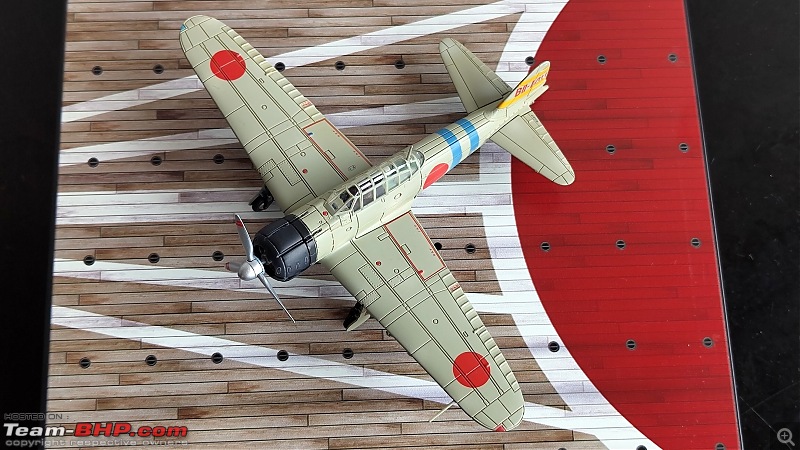 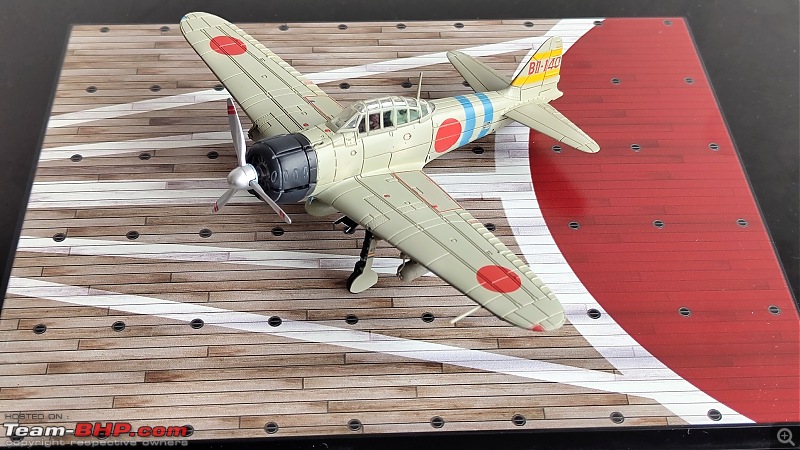 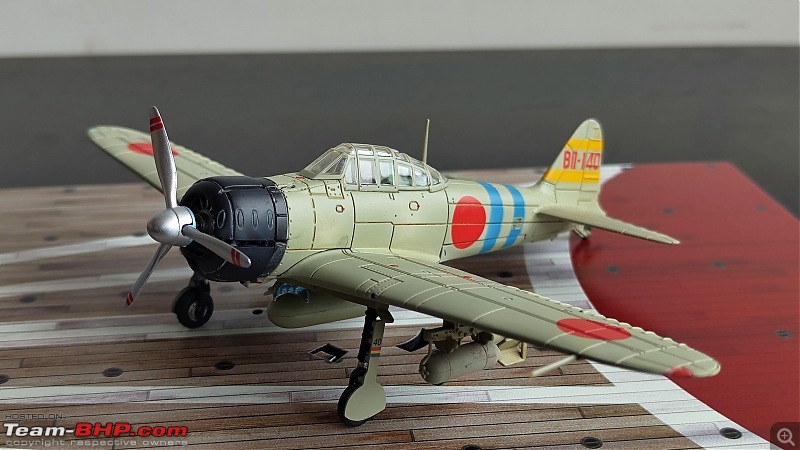 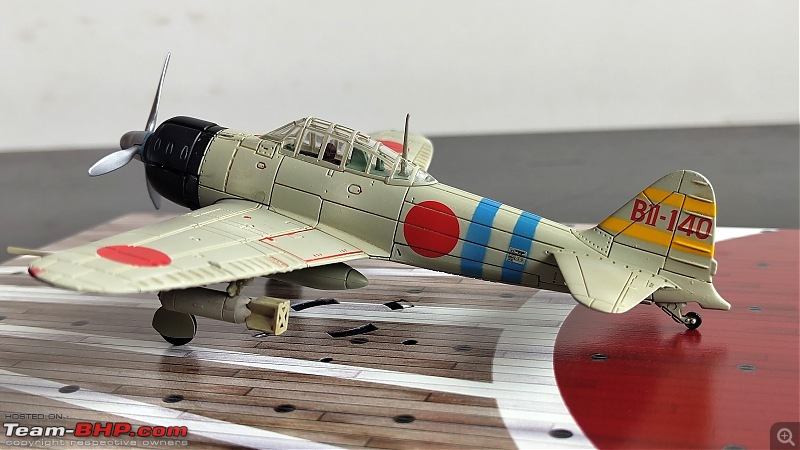 The engine cowlings are removable and they reveal in great detail the Nakajima NK1C Sakae-12 that powered the Zero. 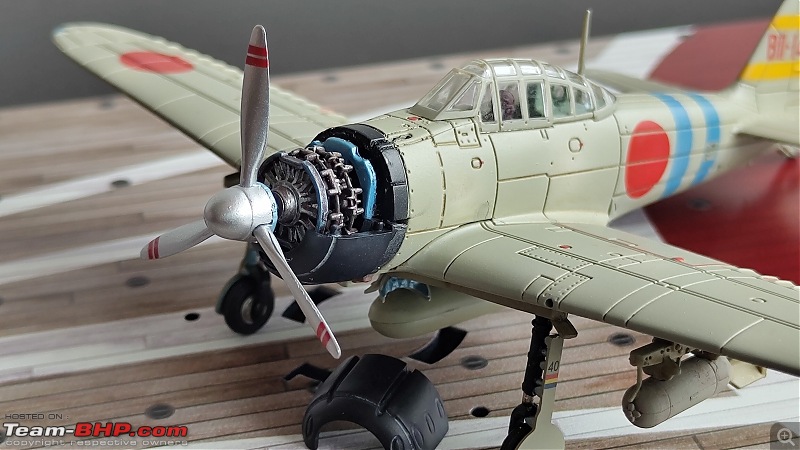 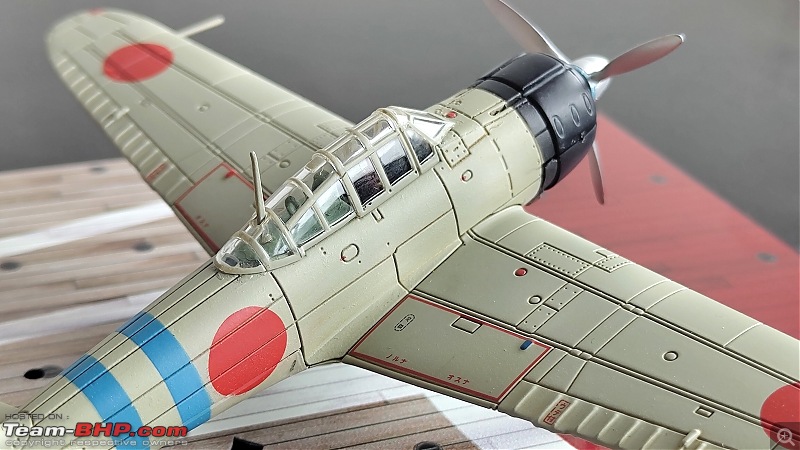 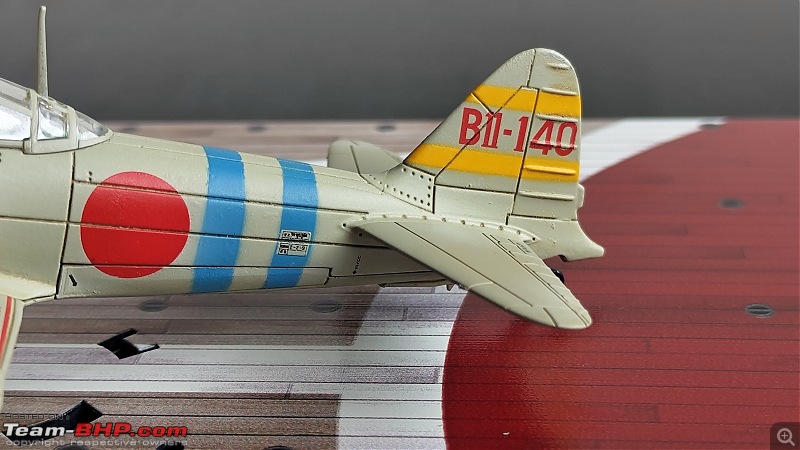 2X Wing mounted 20 mm Type 99 cannons & 2 X 7.7 mm engine cowling mounted Type 97 machine guns. 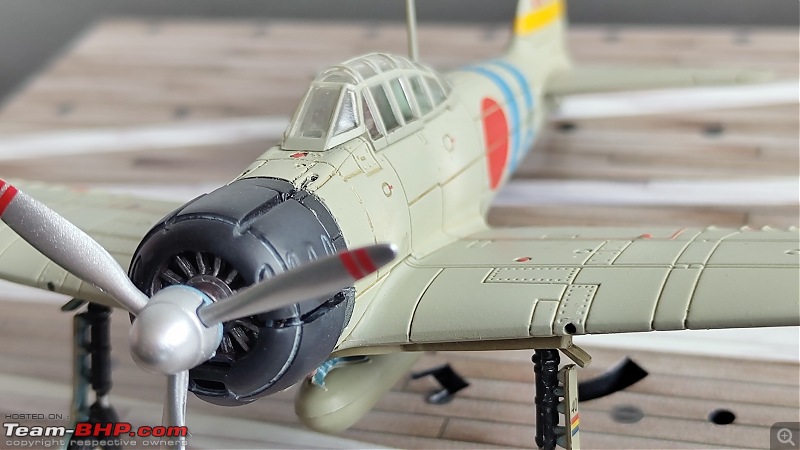 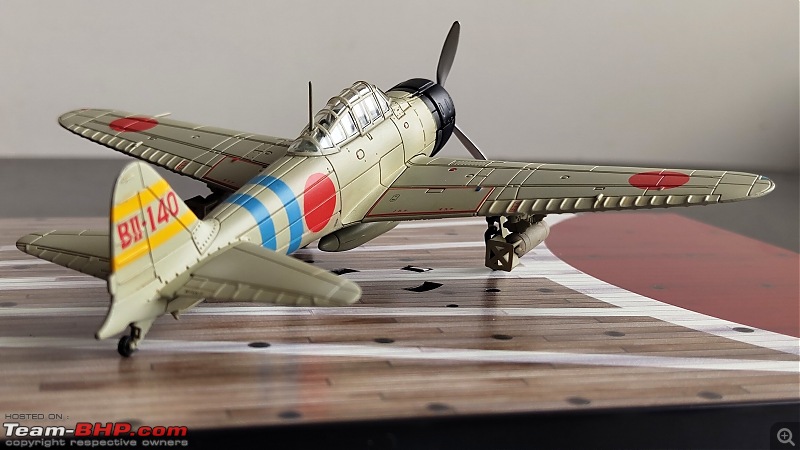 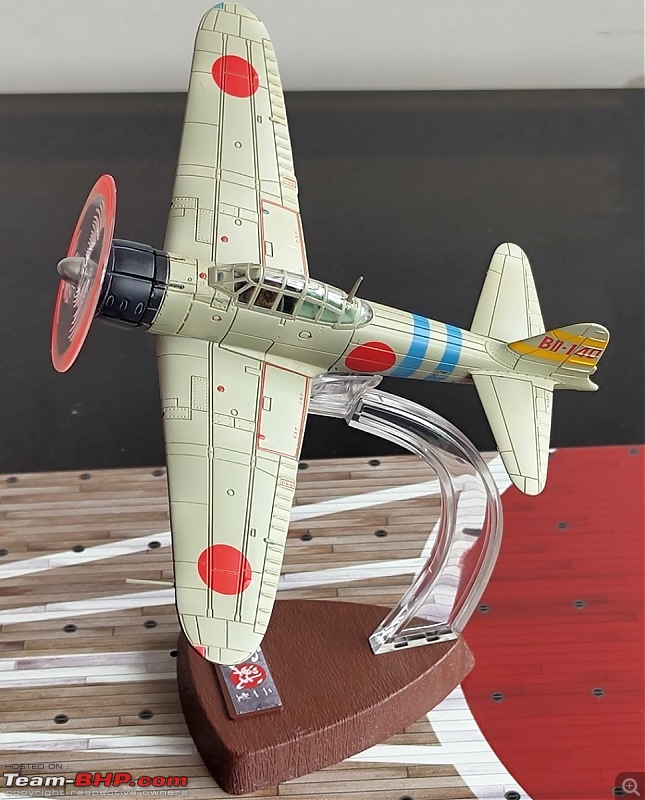 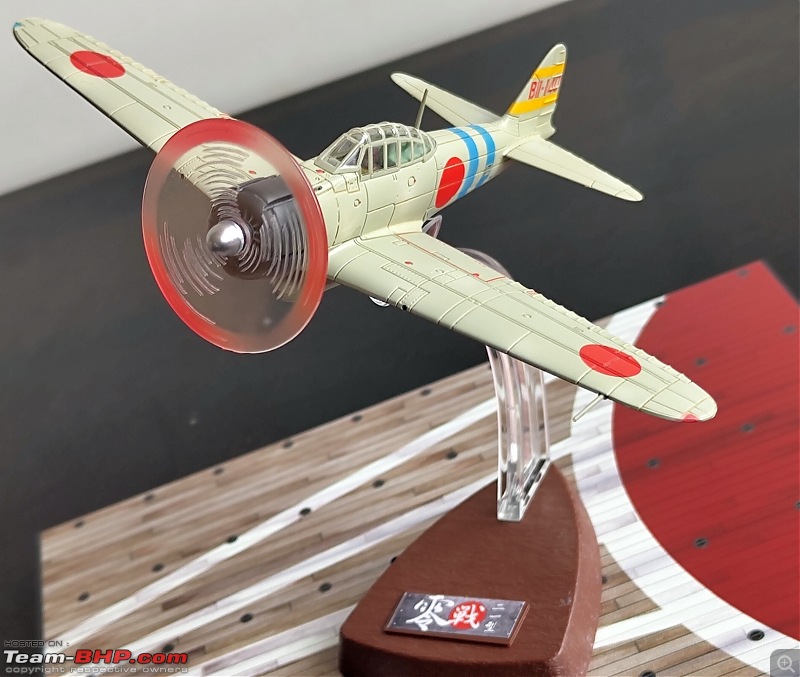 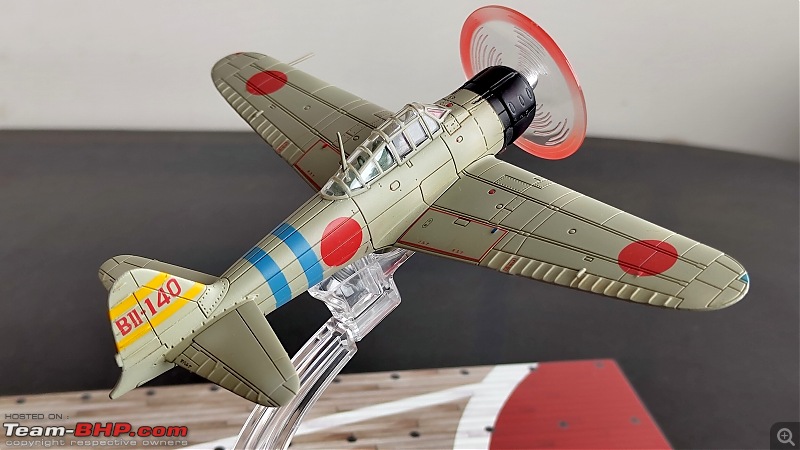 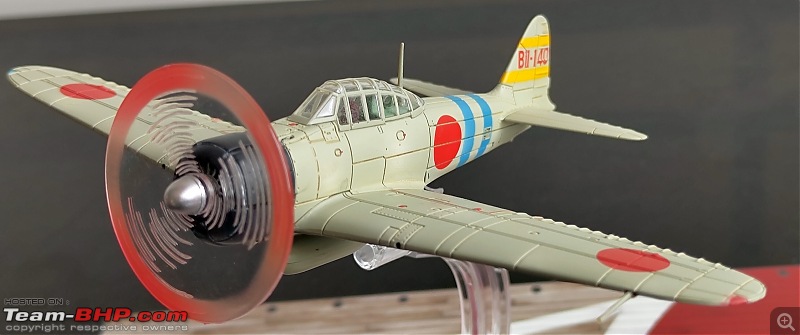 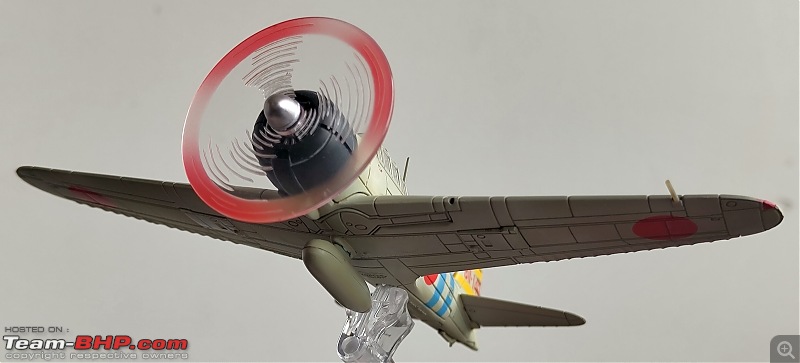 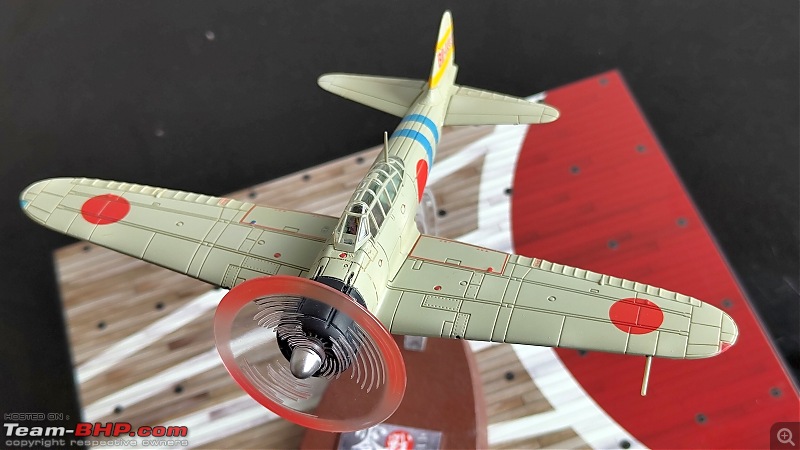 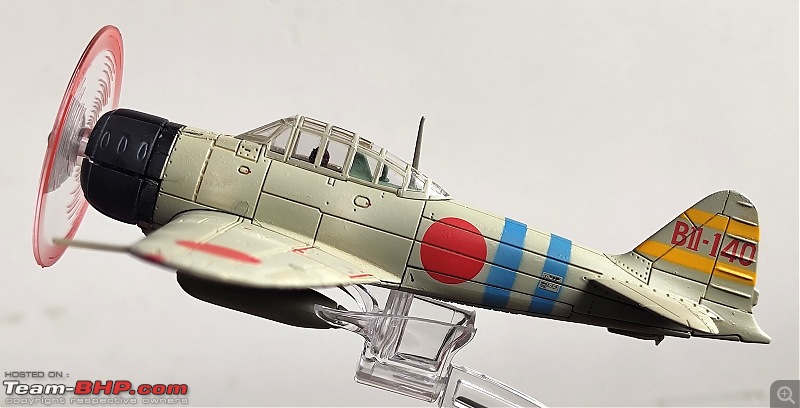 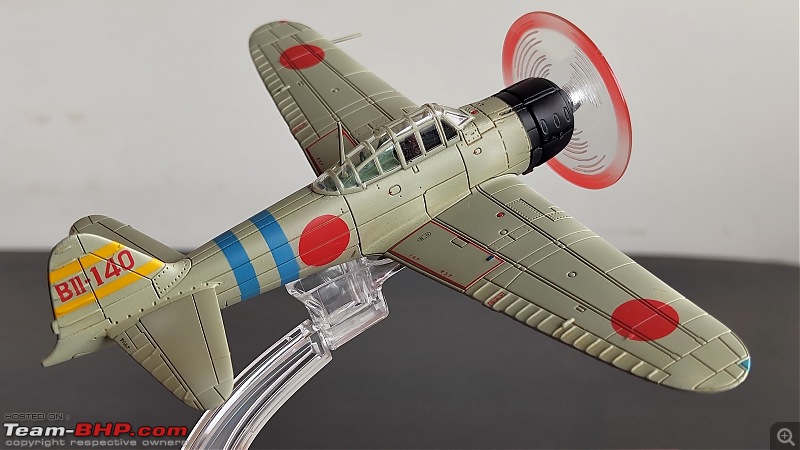 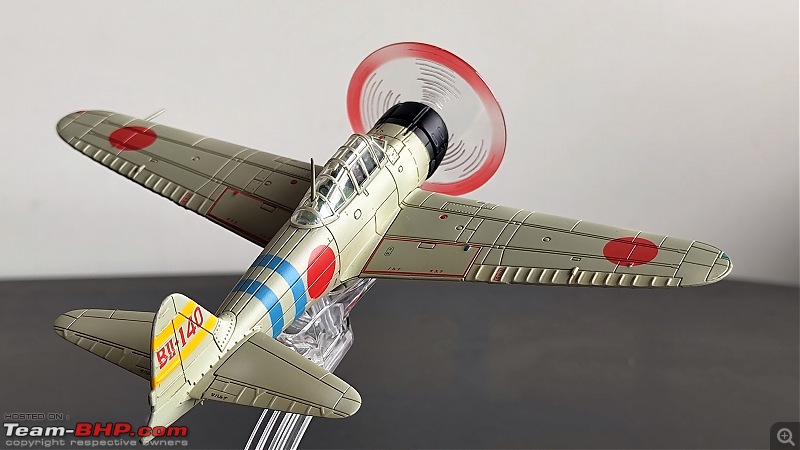 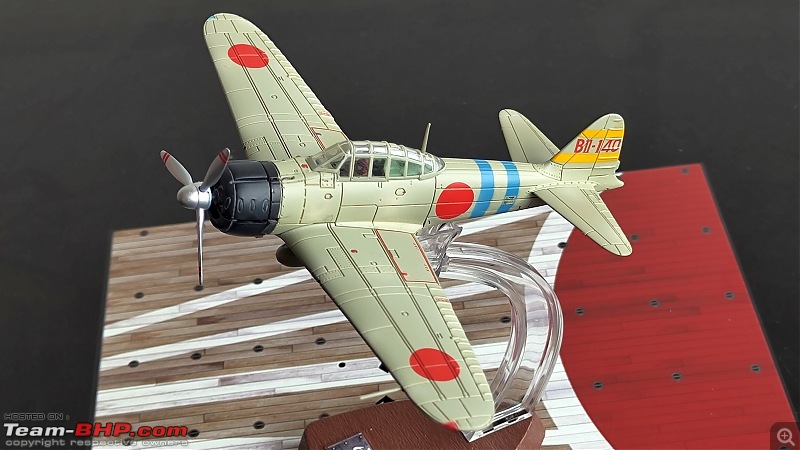 Last edited by skanchan95 : 25th July 2023 at 15:43. |
| |  (5)
Thanks (5)
Thanks
 |
| The following 5 BHPians Thank skanchan95 for this useful post: | badboyscad, Foxbat, sajands, V.Narayan, wolg |
| | #2053 | ||
| BHPian Join Date: Mar 2016 Location: Palakkad
Posts: 608
Thanked: 1,382 Times
| Re: Scale Models - Aircraft, Battle Tanks & Ships Quote:
Quote:
| ||
| |  (3)
Thanks (3)
Thanks
 |
| The following 3 BHPians Thank rohitoasis for this useful post: | Foxbat, skanchan95, V.Narayan |
| | #2054 |
| Senior - BHPian | Re: Scale Models - Aircraft, Battle Tanks & Ships 1:72 Vought F4U-1A Corsair USN VF-17 "Jolly Rogers", White 29, Lt. (JG) Ira Kepford, 1944 Early in the Pacific War, US Navy and Marine Corps fighter pilots found themselves outclassed by the agile and well-armed Japanese A6M Zero, but even then work was underway to provide them with better aircraft. One of those better aircraft was the Vought F4U Corsair, a rugged, powerful, and somewhat unforgiving aircraft that featured a distinctive inverted gull wing. The Corsair was designed and operated as a carrier-based aircraft, and entered service in large numbers with the U.S. Navy in late 1944 and early 1945. It quickly became one of the most capable carrier-based fighter-bombers of World War II. The Corsair proved more than a match for the Zero, and it would also prove to be an excellent fighter-bomber, serving in this role in the Korean War, as well as in the French colonial wars in Indochina and Algeria. The Corsair, as mentioned, had begun its first combat deployment, to Guadalcanal, in early 1943. The first recorded combat engagement was on 14 February 1943, when Corsairs of Marine Squadron VMF-124 under Major William E. Gise assisted P-40 Warhawks and P-38 Lightnings in escorting B-24 Liberators on raids against the major Japanese base at Bougainville at the northwest corner of the Solomons. Japanese fighters contested the raid and the Americans got the worst of it, with four P-38s, two P-40s, two Corsairs, and two Liberators lost. No more than four Japanese Zeroes were destroyed. A Corsair was responsible for one of the "kills", but it wasn't anything to boast about, since it was due to a midair collision. The fiasco was referred to as the "Saint Valentine's Day Massacre". Although the Corsair's combat debut was unimpressive, the Marines quickly learned how to make better use of the machine and demonstrate its superiority over Japanese fighters. By April 1943, the Corsair was getting the upper hand. By May, VMF-124 had produced the first Corsair ace, 2nd Lieutenant Kenneth A. Walsh, who would rack up a total of 21 kills during the war. According to old stories, the Japanese learned to call the F4U "Whistling Death" because of the high-pitched sound it made, though such a melodramatic name sounds suspiciously like an invention of American publicists. It was also known as the "Bent Wing Bird" -- though this name sounds suspiciously like something out of company press releases. Whatever the enemy or the aircrew actually called the F4U, it was still a machine to be reckoned with, one way or another. Many pilots became aces in the Corsair, but even its most smitten advocates admitted that it was a handful. The most prominent gang of Marine Corsair pilots was squadron VMF-214, led by Major (later Colonel) Greg "Pappy" Boyington. Boyington was a rowdy, tough, hard-drinking Marine who had flown Curtiss P-40s with Claire Chennault's American Volunteer Group (AVG) or "Flying Tigers" in China, and scored two kills there. Chennault had thrown him out after somebody broke into the liquor locker -- concluding that Boyington was responsible, because nobody else in the Flying Tigers was strong enough to have wrenched open the padlock with his bare hands. VMF-214 "Boyington's *******s" or "Black Sheep" racked up large scores against the Japanese in the South Pacific, with Boyington claiming a total of 28 kills during his combat career, 22 of them in the F4U. He was shot down and captured by the Japanese on 3 January 1944, to spend the rest of the war in a prison camp; the Japanese did not announce his capture, and Boyington was presumed killed in action. He would get the Medal of Honor after his release from captivity at the end of the war. After finally working out the worst bugs, the Navy finally embraced the Corsair as the most capable fighter and fighter-bomber in its inventory, superior to the Grumman F6F-3 Hellcat. By early 1944, the Navy was making good use of the Corsair. The first Navy F4U squadron, VF-17 "Jolly Rogers" AKA "Skull & Crossbones", produced 12 aces, the most prominent being Lieutenant Ira Kepford, with 19 kills. Ira Cassius Kepford (May 29, 1919 – January 19, 1987) was an American flying ace of World War II who served with a land-based unit of the United States Navy. In 76 days of combat flying with the VF-17 "Jolly Rogers," he was credited with shooting down 16 enemy aircraft. At the close of his combat service in April 1944, Kepford was the Navy's leading ace. 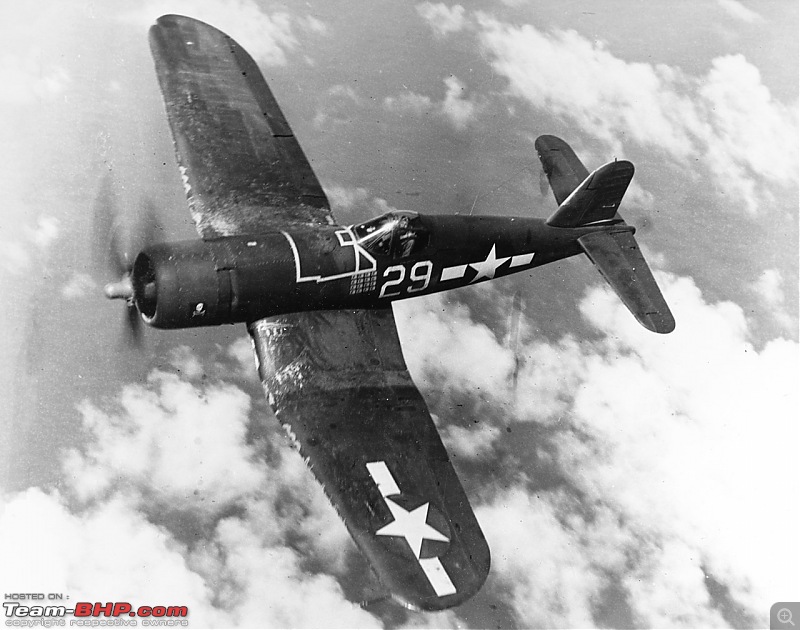 Ira Kefpord's F4U-1A Corsair 29 White 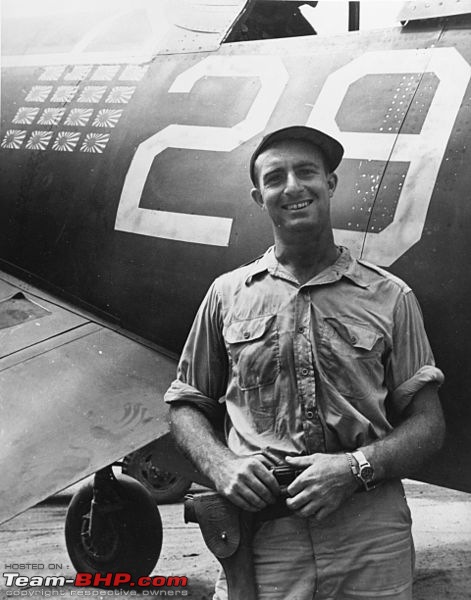 The man himself 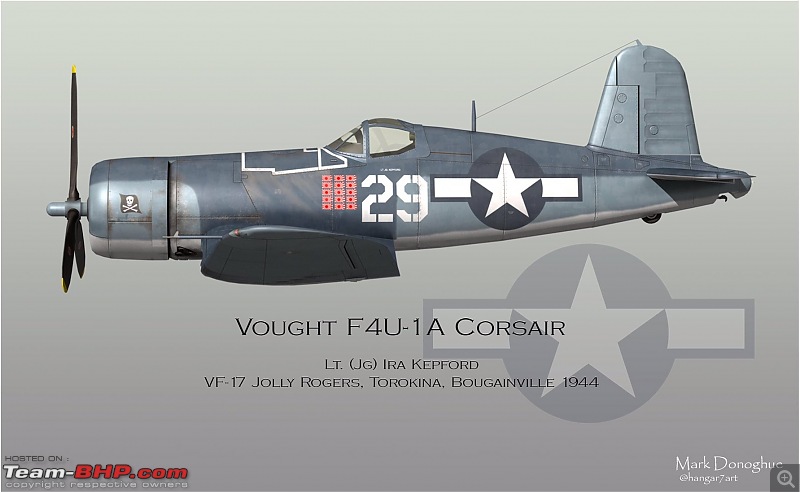 VF-17 VF-17 was established on 1 January 1943, at NAS Norfolk, with Lieutenant Commander John T. "Tommy" Blackburn as its commander. It was the second Navy fighter squadron to receive the F4U-1 Corsair and the most successful of them all. Blackburn wanted a squadron insignia that had a piratical theme to it to match the F4U's Corsair designation; hence the skull and crossbones were chosen.The original design was developed by Harry Hollmeyer, who became an ace pilot. The squadron helped during the development of the F4U Corsair resulting in some design changes, resulting in the F4U-1A. Unfortunately, the Navy still deemed the Corsair unfit for carrier service and instead of joining USS Bunker Hill, VF-17 became a land-based squadron in the Solomon Islands during most of its deployment to the South Pacific. On 8 November 1943, the squadron executive officer, Roger Hedrick, led a flight which intercepted 39 Japanese fighters over Empress Augusta Bay, Bougainville. As the Japanese fighters fled back to their base, VF-17 was responsible for downing 3 fighters and damaging 4 others. Though outnumbered, the squadron survived the encounter with no losses. This action was typical of the squadron's land-based service in the Solomon Islands in 1943 and 1944, when it went up against the cream of Imperial Japanese Navy pilots then based at Rabaul. In its two tours of duty in the Solomon Islands, VF-17 had 152 aerial victories and produced 11 aces. VF-17 finished its combat tour on 10 May 1944, was equipped with the F6F-5 Hellcat and moved to the USS Hornet. Here, the squadron amassed 161 victories, and produced 12 aces. Overall, the two combat tours of VF-17 were credited with 313 victories, the most of any US Navy squadron. Statistics compiled at the end of the war indicate that the F4U flew over 64,000 operational sorties for the US Marines and US Navy through the conflict, with fewer than 10,000 of these sorties from carrier decks. The total number of kills claimed was 2,139, against 189 combat losses of F4Us, for a kill ratio of over 11:1. Even if that was exaggerated by a factor of two, it was still an accomplishment. One particularly interesting kill was scored by a Marine Lieutenant R.R. Klingman over Okinawa. According to the story, he was in pursuit of a Kawasaki Ki-45 Toryu twin engine fighter when his guns jammed, so he simply flew up and chopped off the Ki-45's tail with the big propeller of the Corsair. General characteristics Crew: One Length: 33 ft 8 in (10.26 m) Wingspan: 41 ft 0 in (12.50 m) Height: 14 ft 9 in (4.50 m) Wing area: 314 sq ft (29.17 m2) Empty weight: 9,205 lb (4,238 kg) Gross weight: 14,670 lb (6,654 kg) Max takeoff weight: 14,533 lb (6,592 kg) Powerplant: 1 × Pratt & Whitney R-2800-18W radial engine, 2,380 hp (1,770 kW) Propellers: 4-bladed Performance Maximum speed: 446 mph (717 km/h, 385 kn) Cruise speed: 215 mph (346 km/h, 187 kn) Stall speed: 89 mph (143 km/h, 77 kn) Range: 1,005 mi (1,617 km, 873 nmi) Combat range: 328 mi (528 km, 285 nmi) Service ceiling: 41,500 ft (12,600 m) Rate of climb: 4,360 ft/min (22.1 m/s) Armament Guns: 6 × 0.50 in (12.7 mm) M2 Browning machine guns 375-400 rounds per gun or 4 × 0.79 in (20 mm) AN/M3 cannon, 231 rounds per gun Rockets: 8 × 5 in (12.7 cm) high velocity aircraft rockets and/or Bombs: 4,000 pounds (1,800 kg) 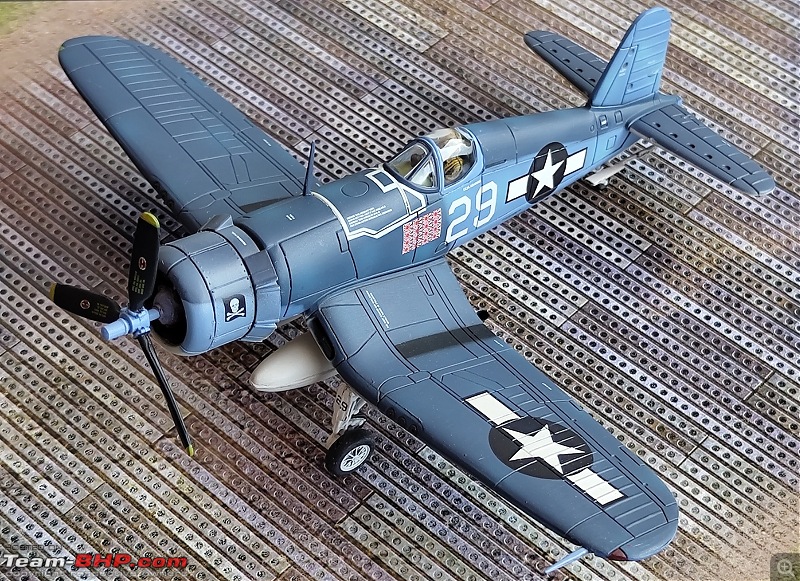 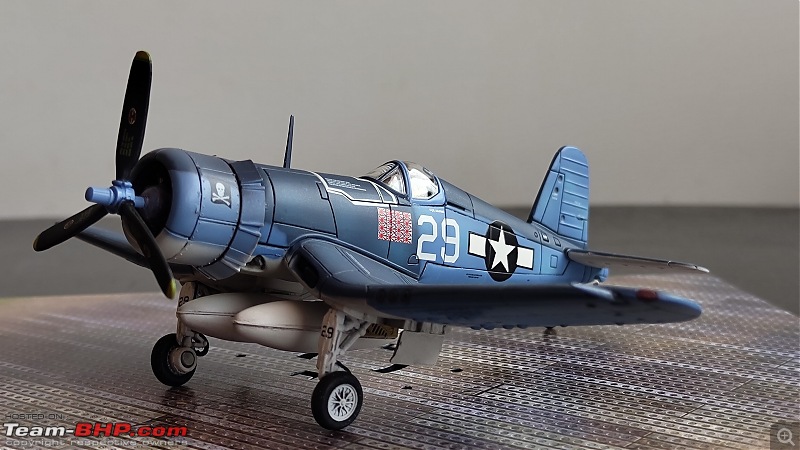 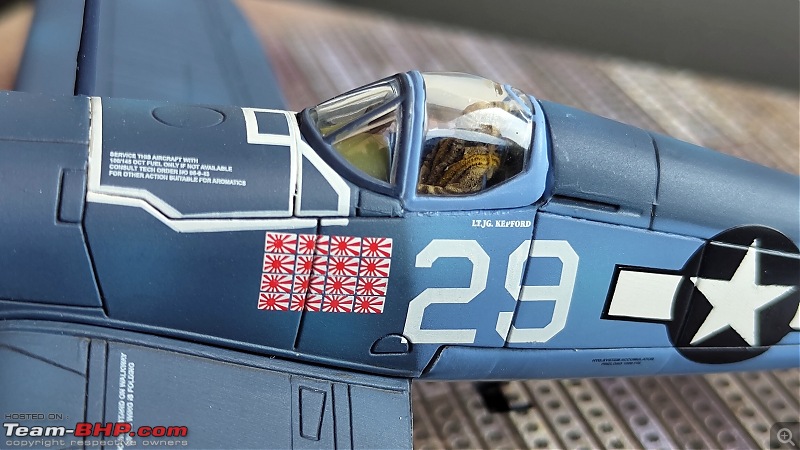 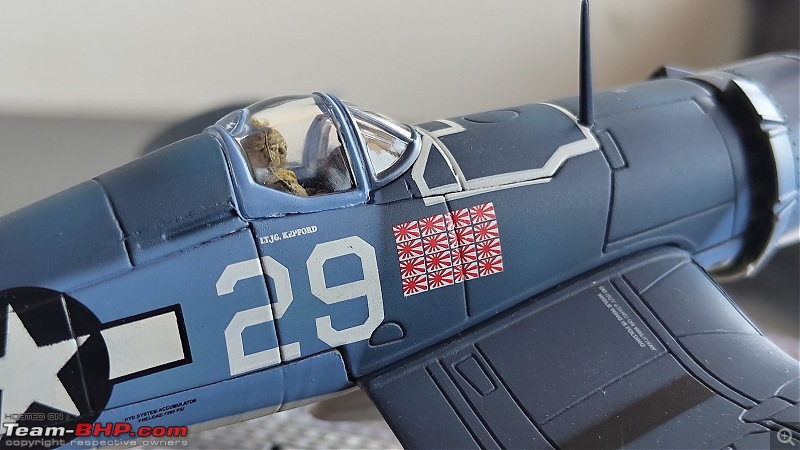 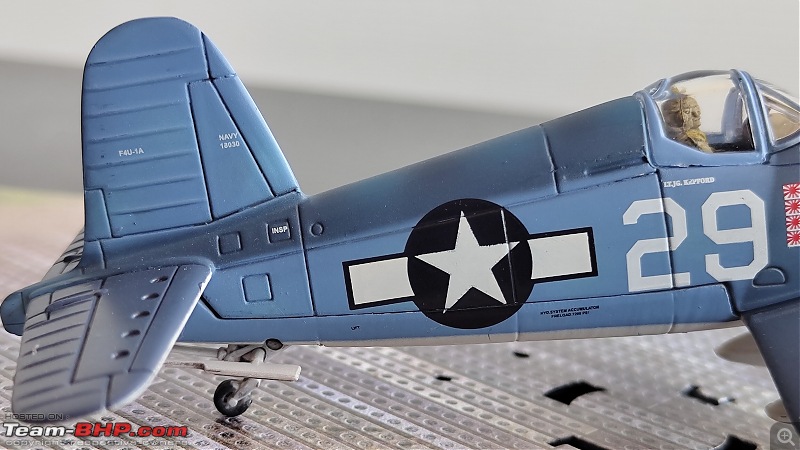 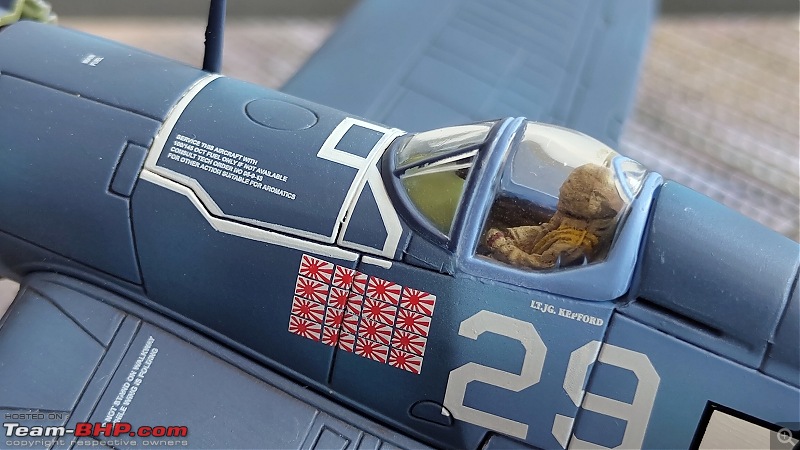 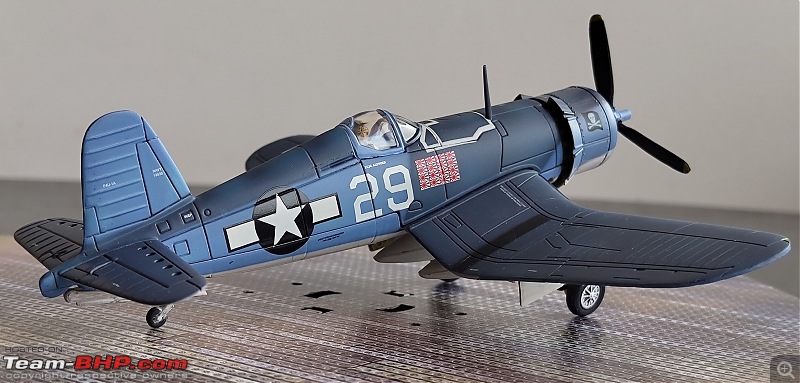 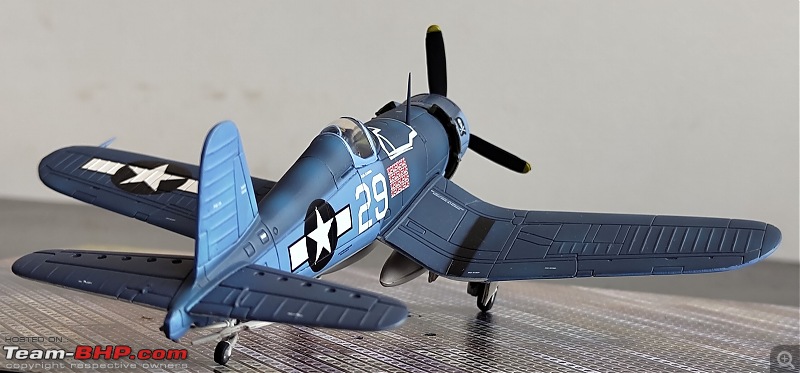 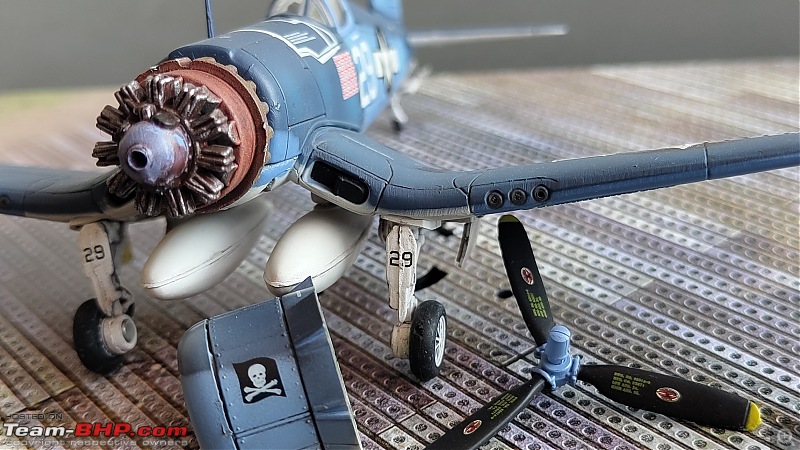 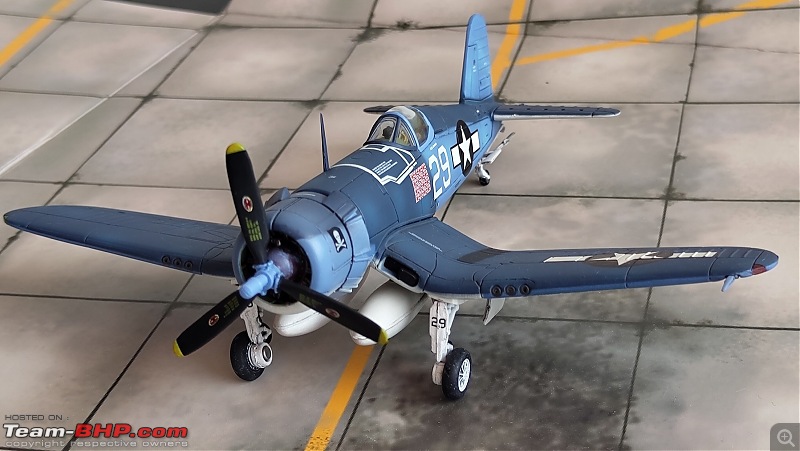 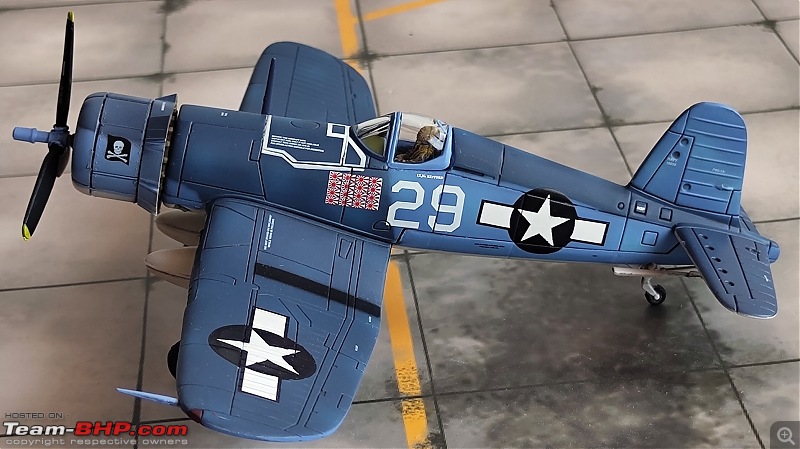 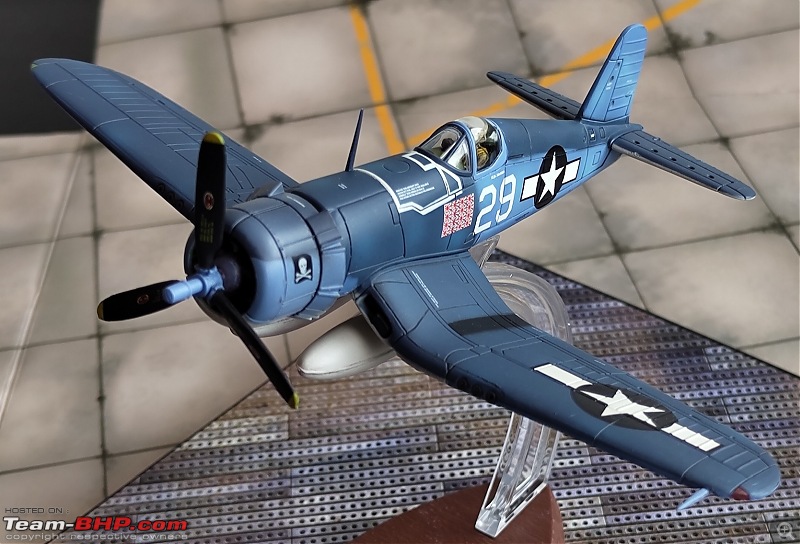 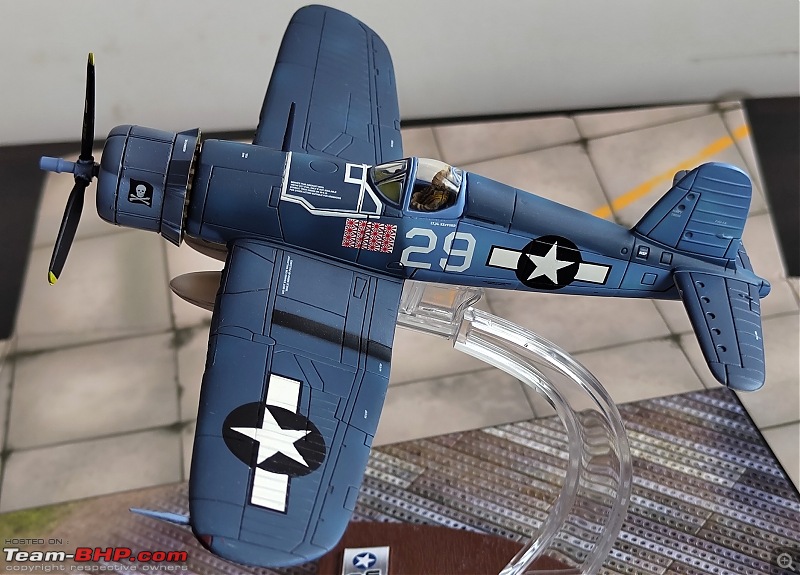 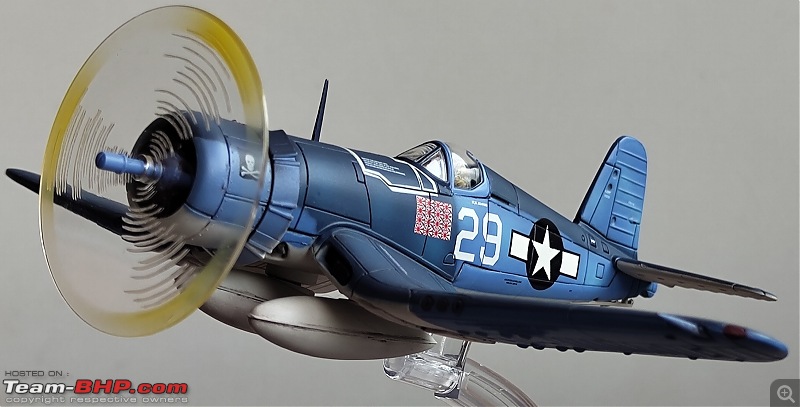 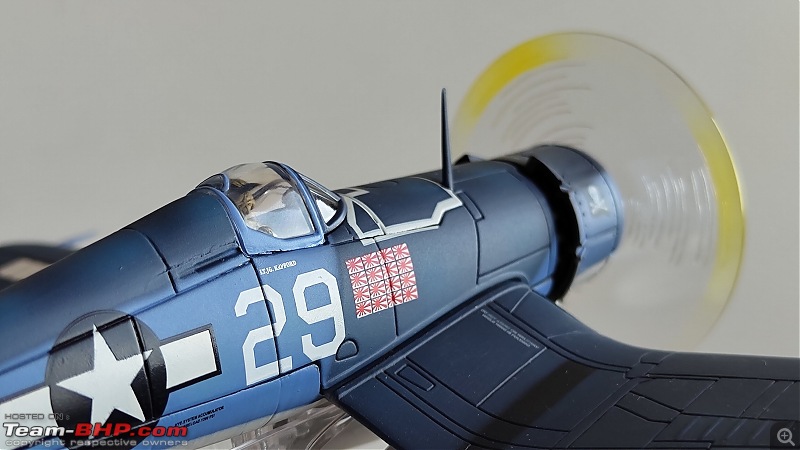 Vought's Finest - F4U Corsair (I) & A-7 Corsair II 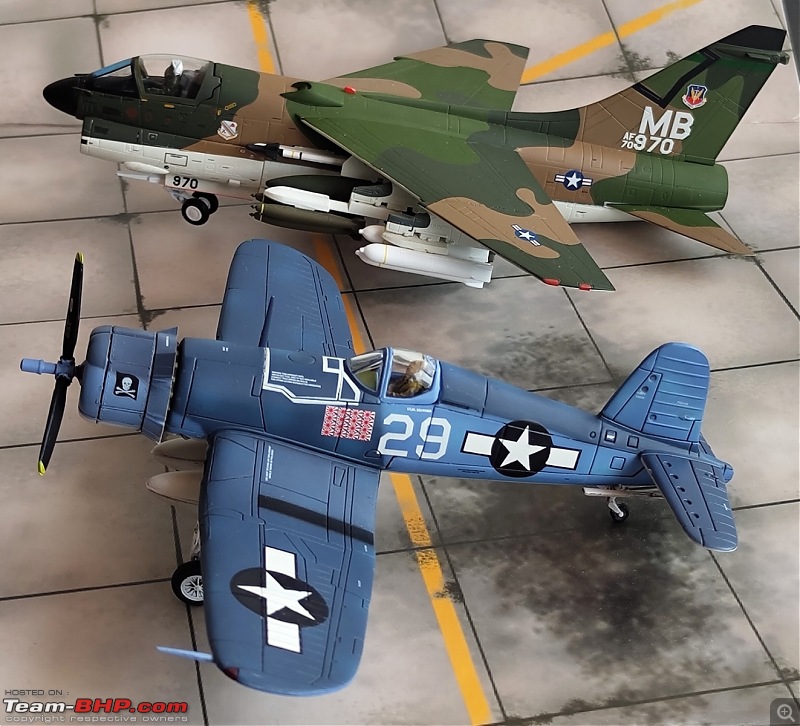 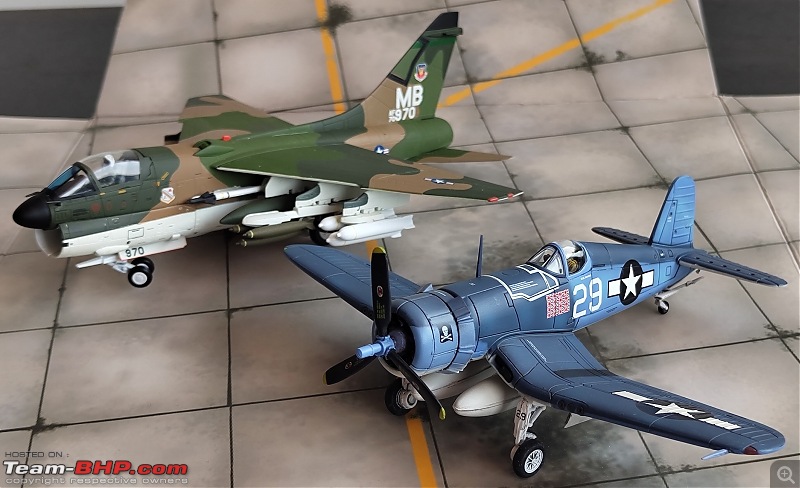 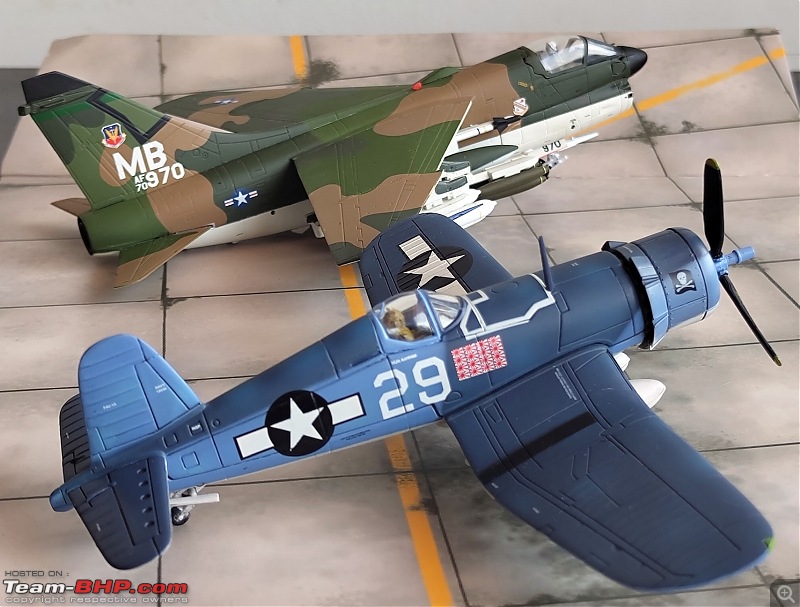 Last edited by skanchan95 : 28th July 2023 at 15:53. |
| |  (4)
Thanks (4)
Thanks
 |
| The following 4 BHPians Thank skanchan95 for this useful post: | badboyscad, Foxbat, Jeroen, V.Narayan |
| | #2055 |
| Senior - BHPian | Re: Scale Models - Aircraft, Battle Tanks & Ships |
| |  (5)
Thanks (5)
Thanks
 |
| The following 5 BHPians Thank skanchan95 for this useful post: | badboyscad, Foxbat, Jeroen, sajands, V.Narayan |
 |



